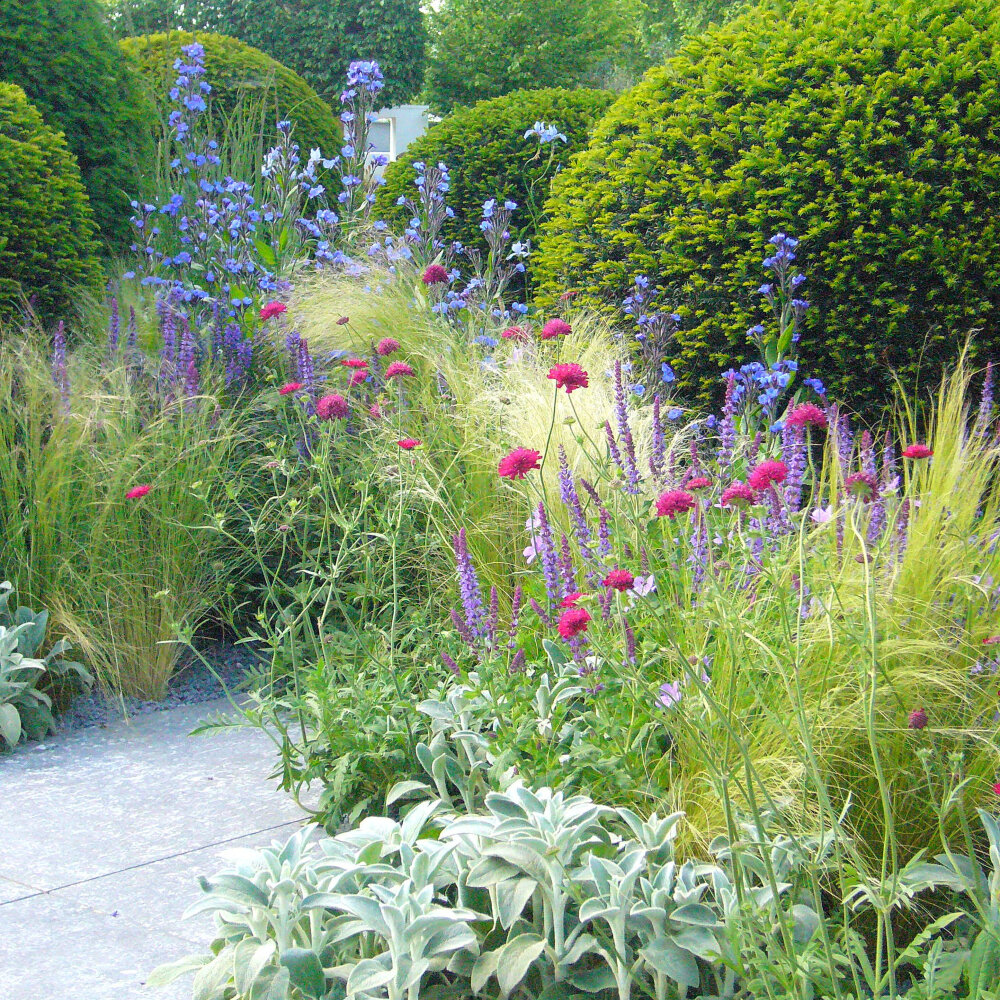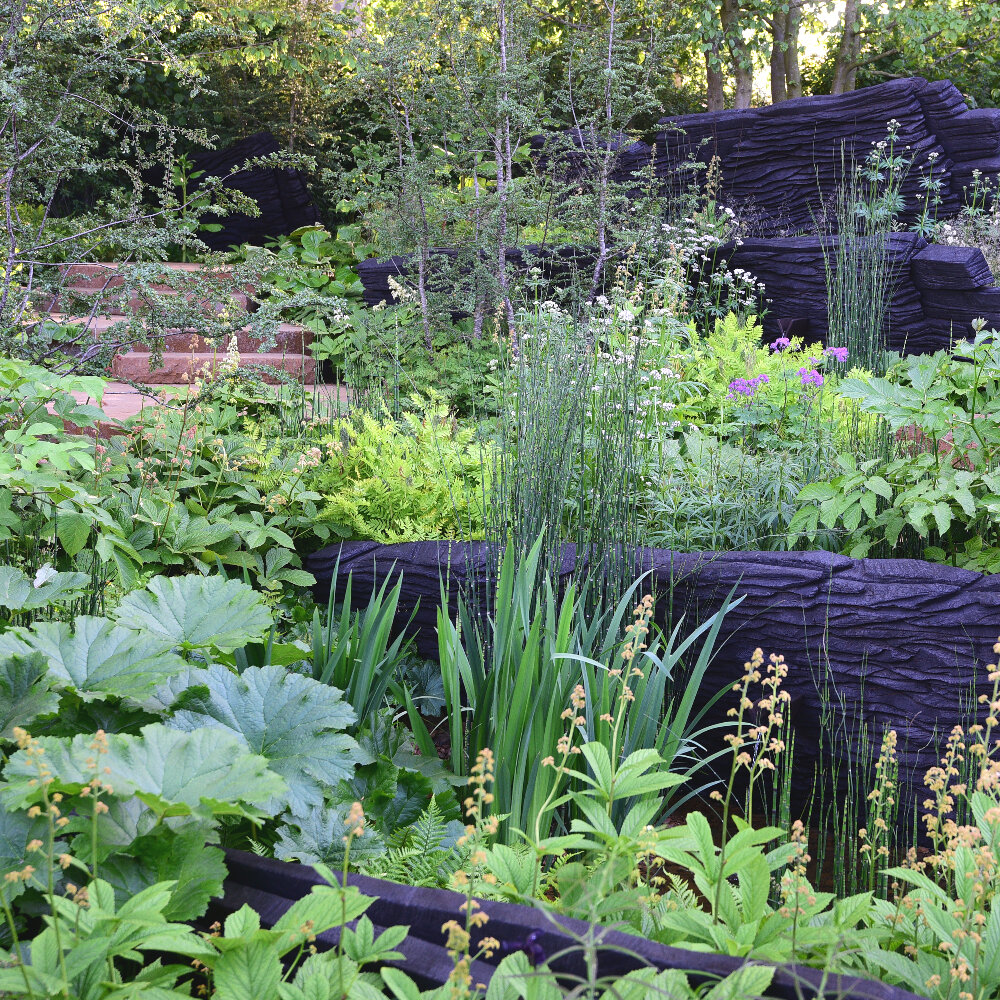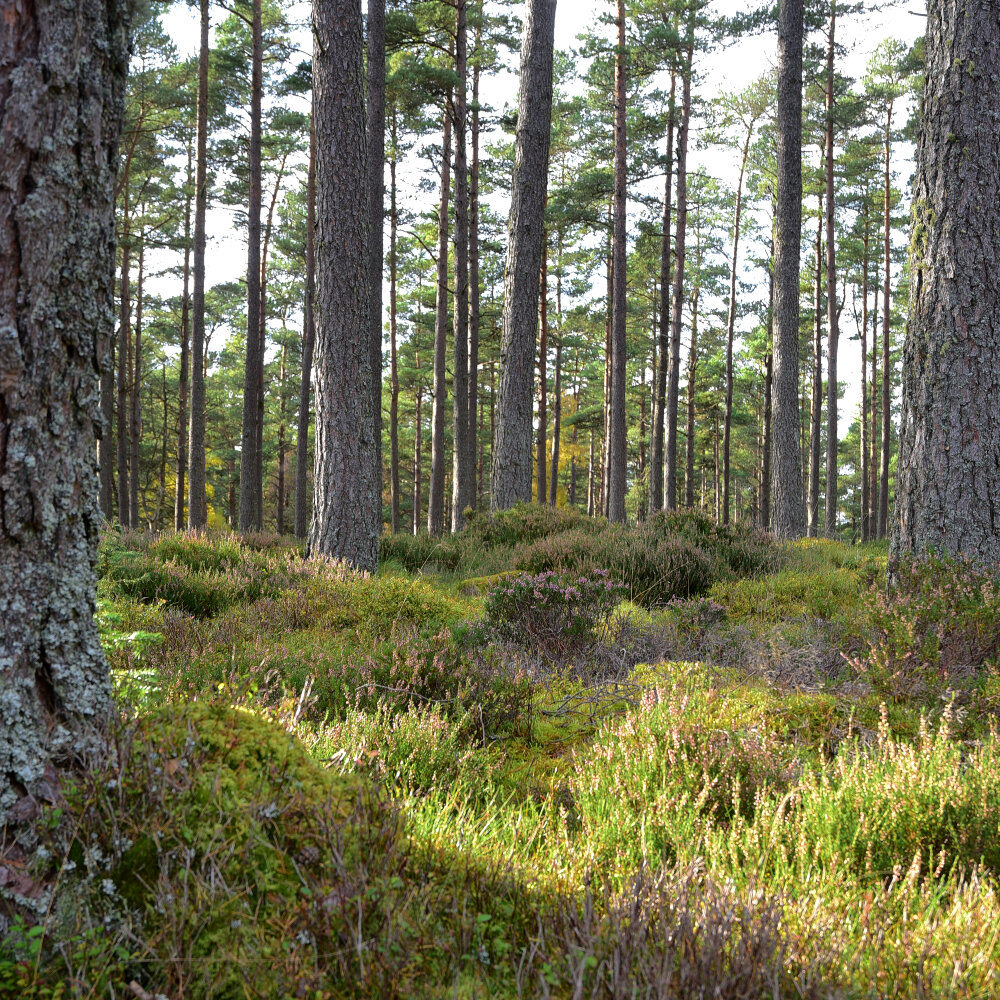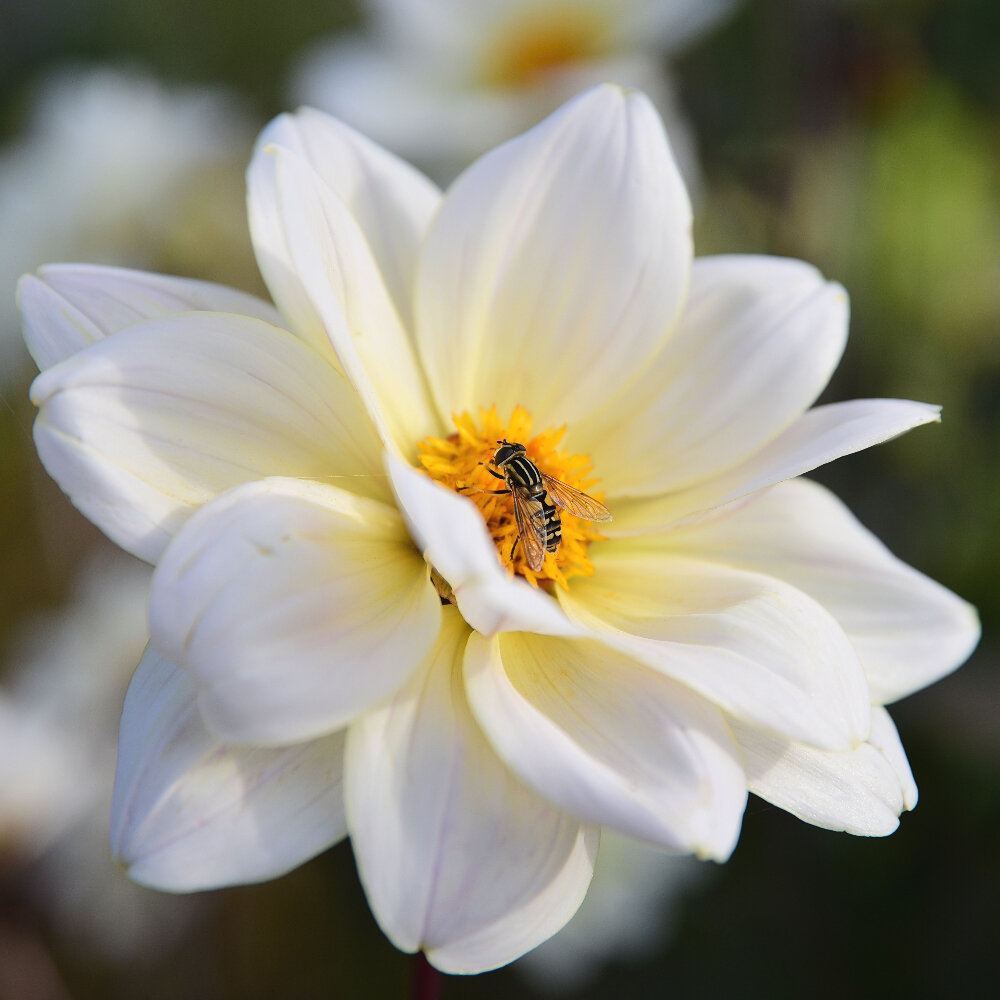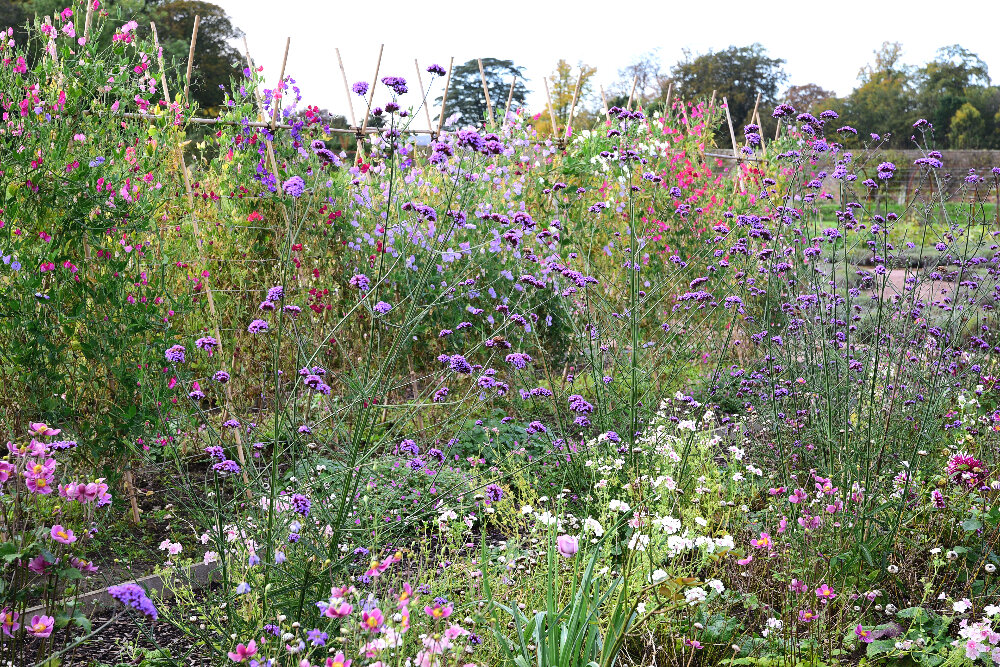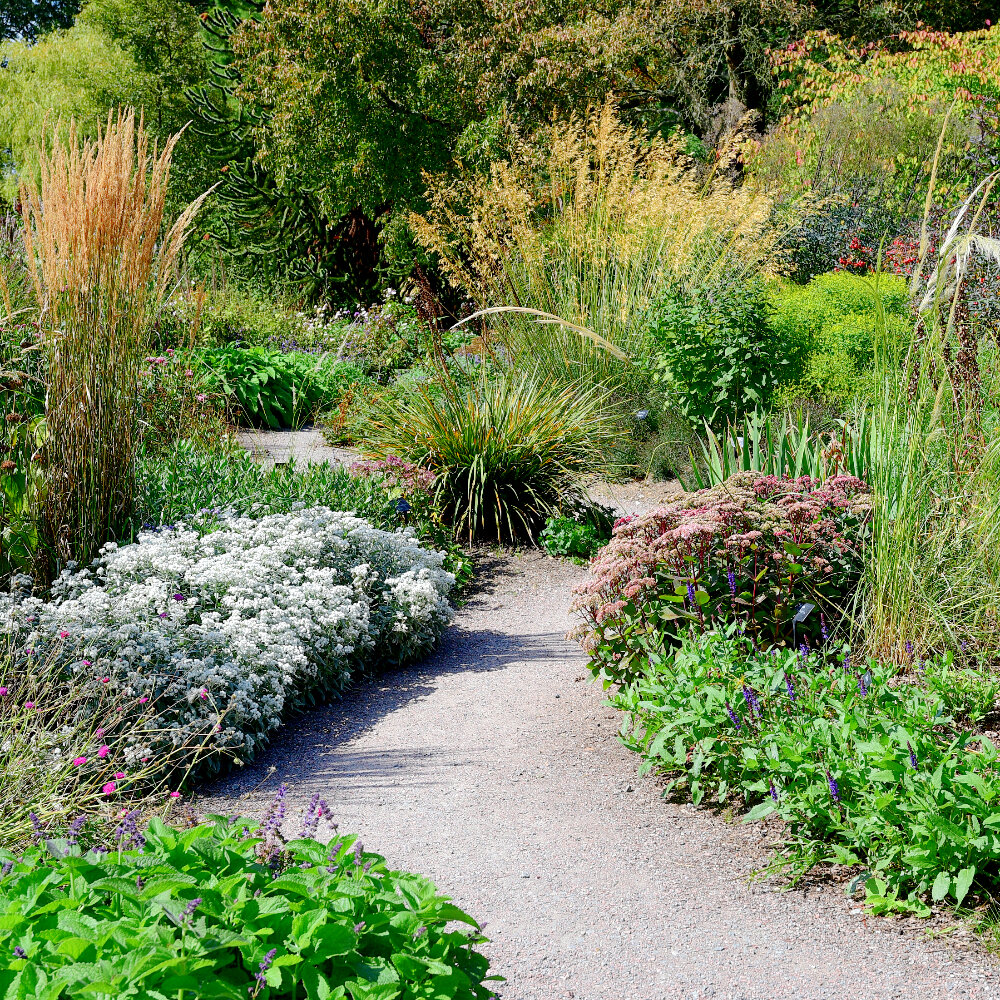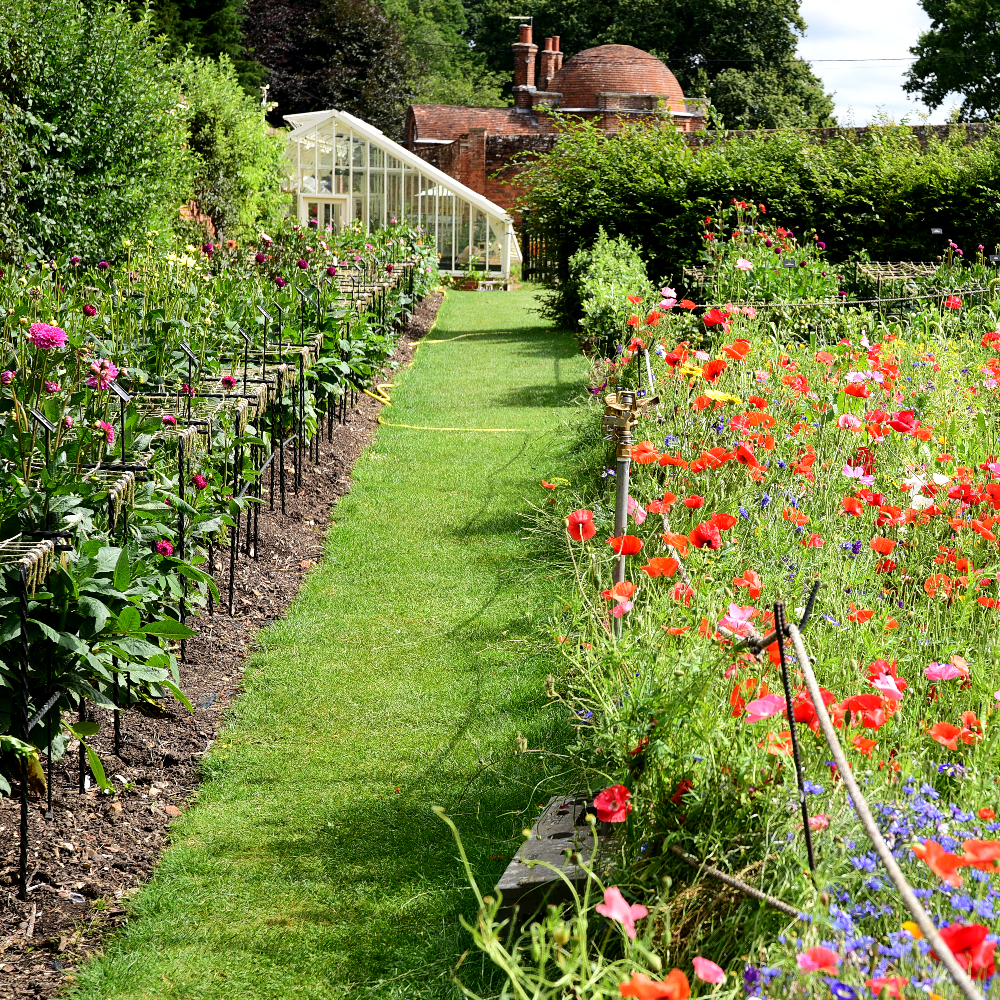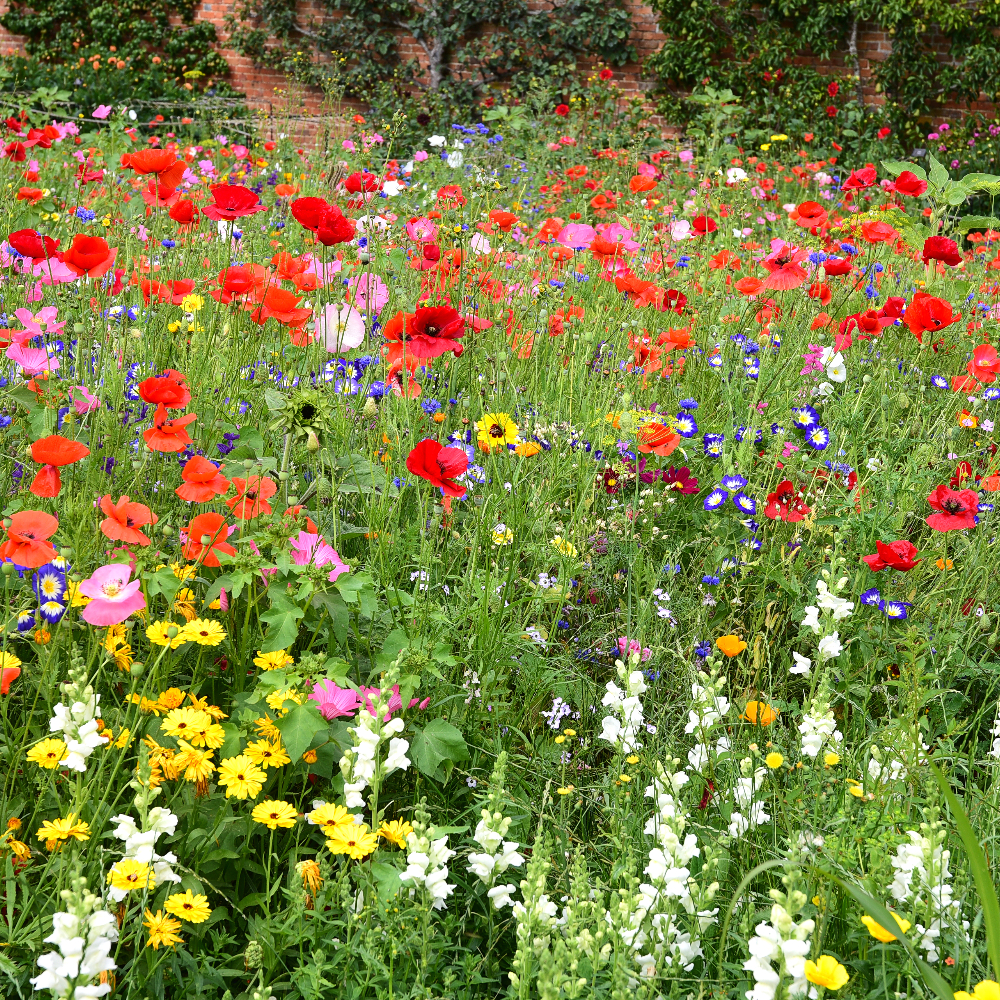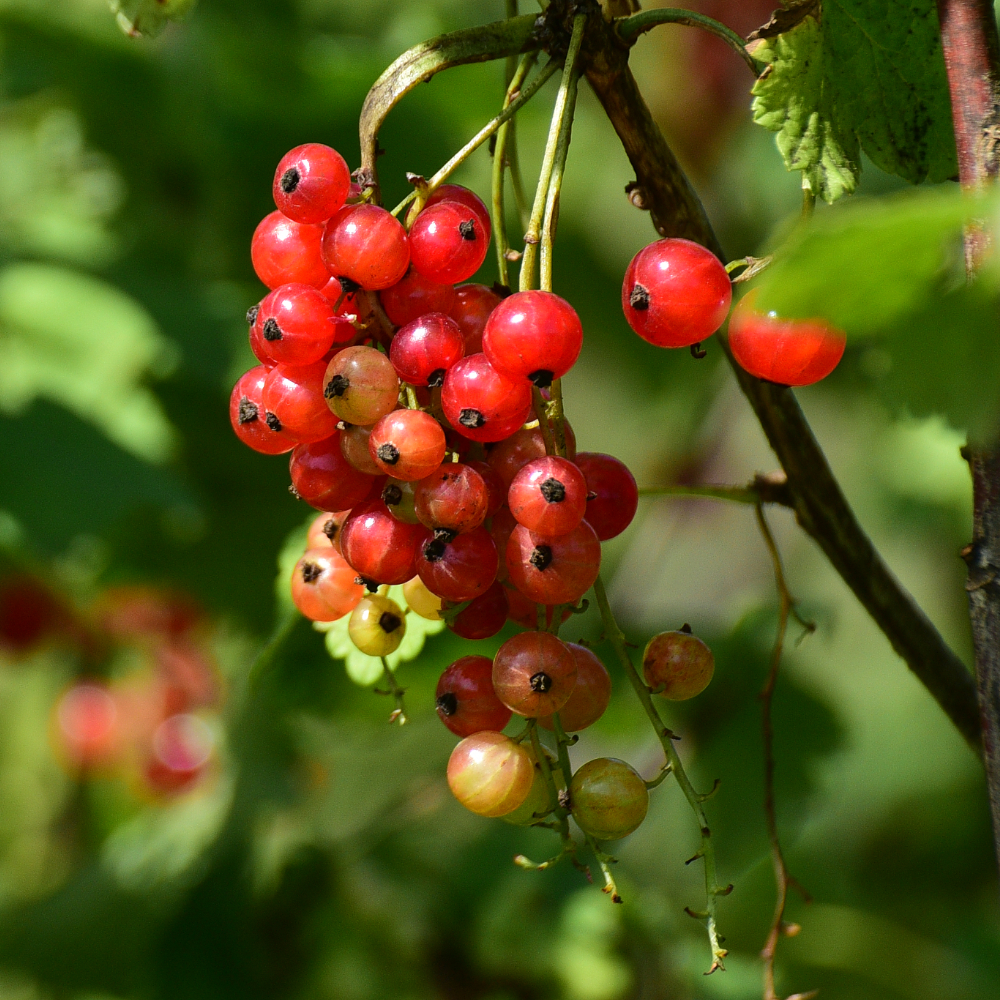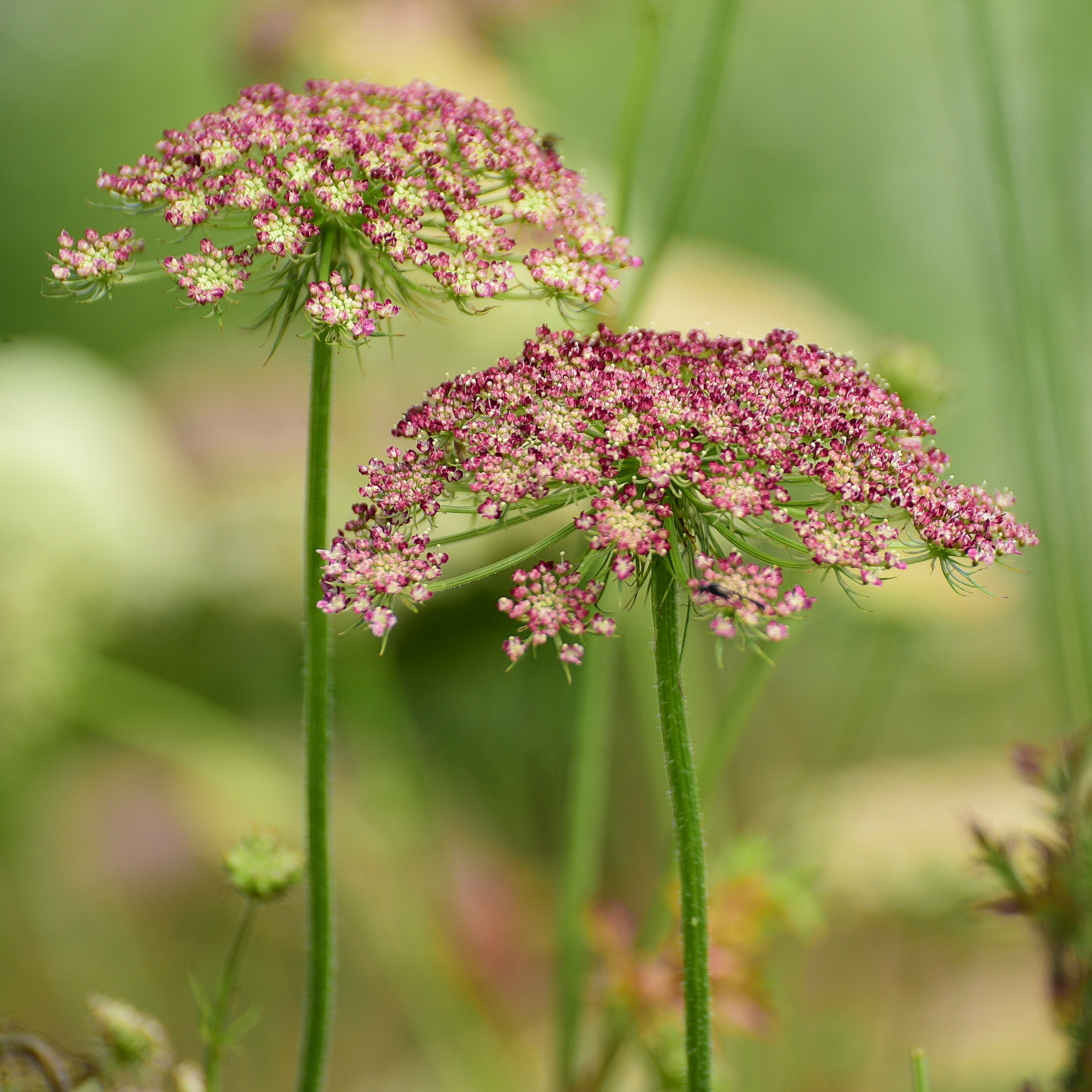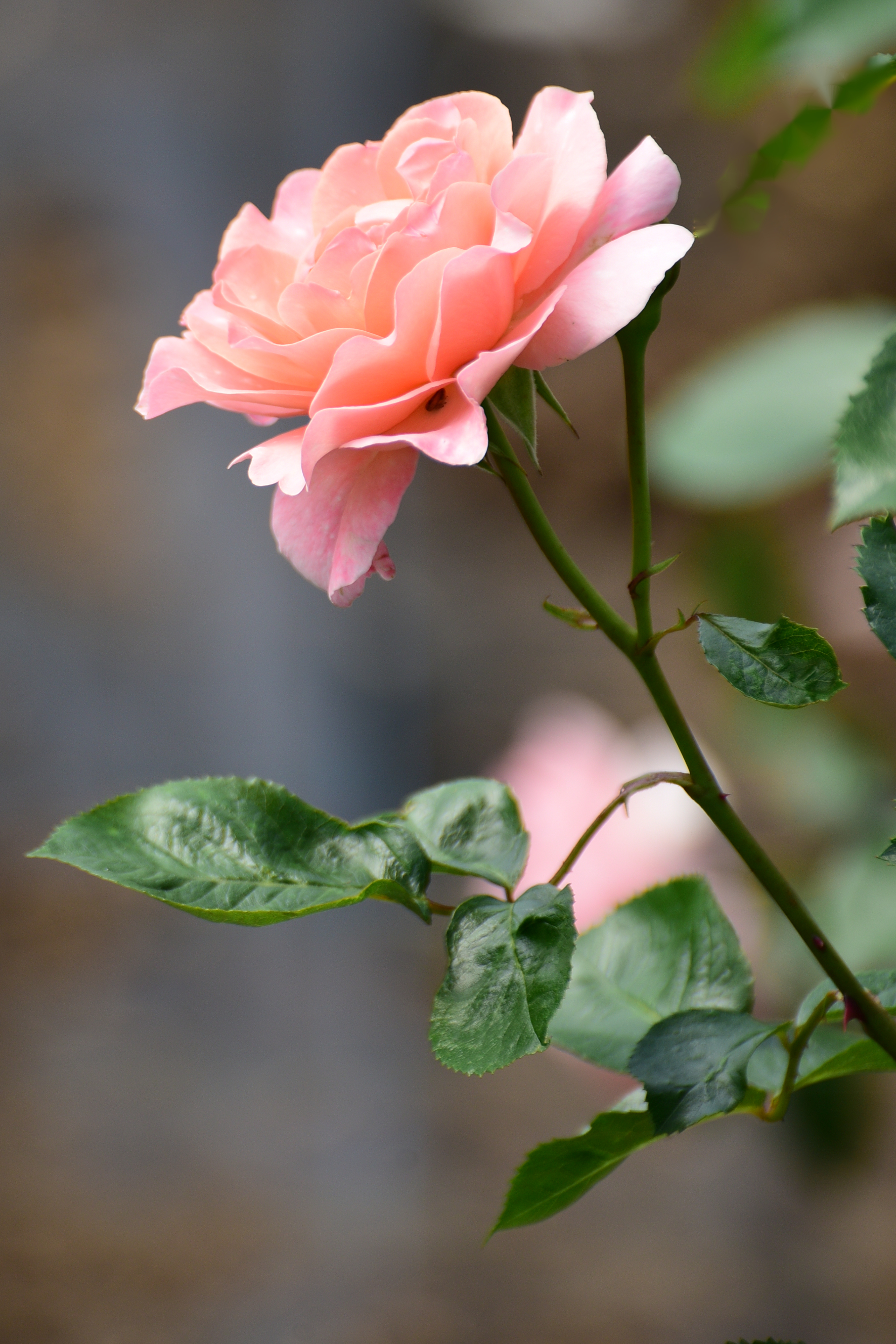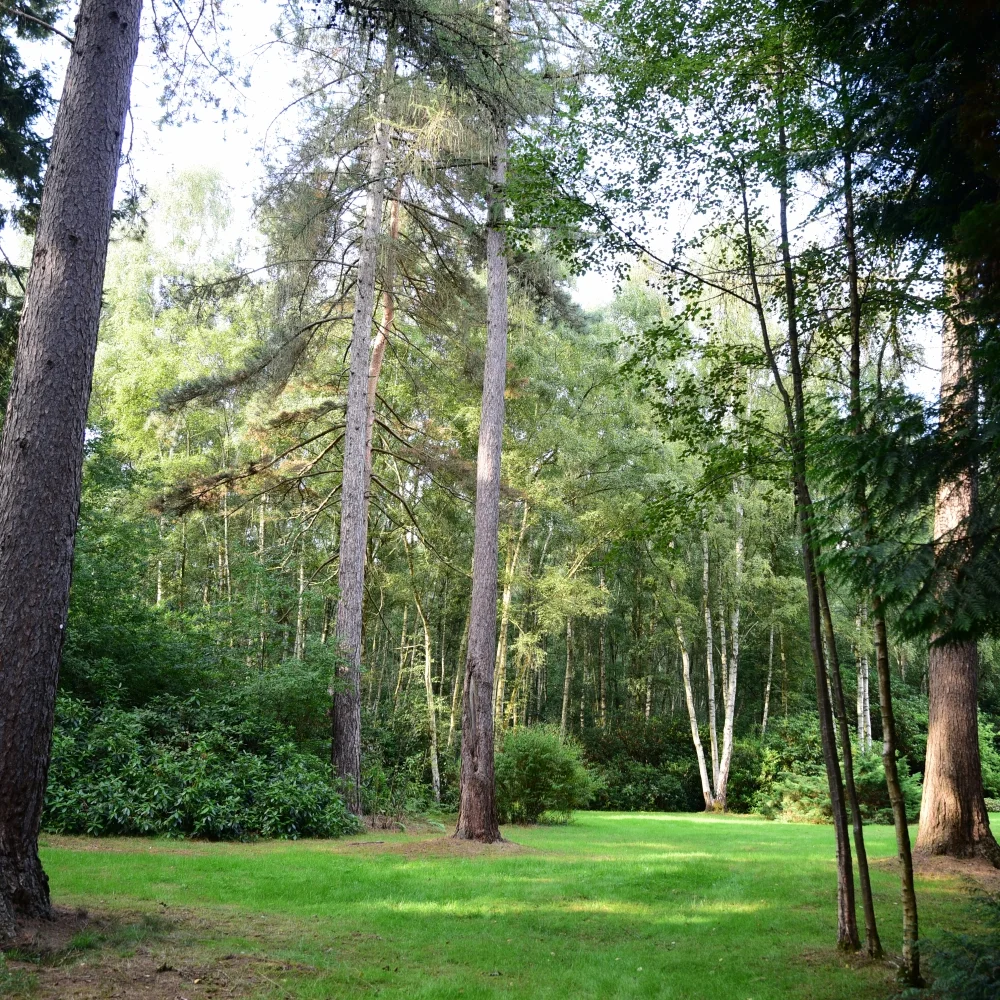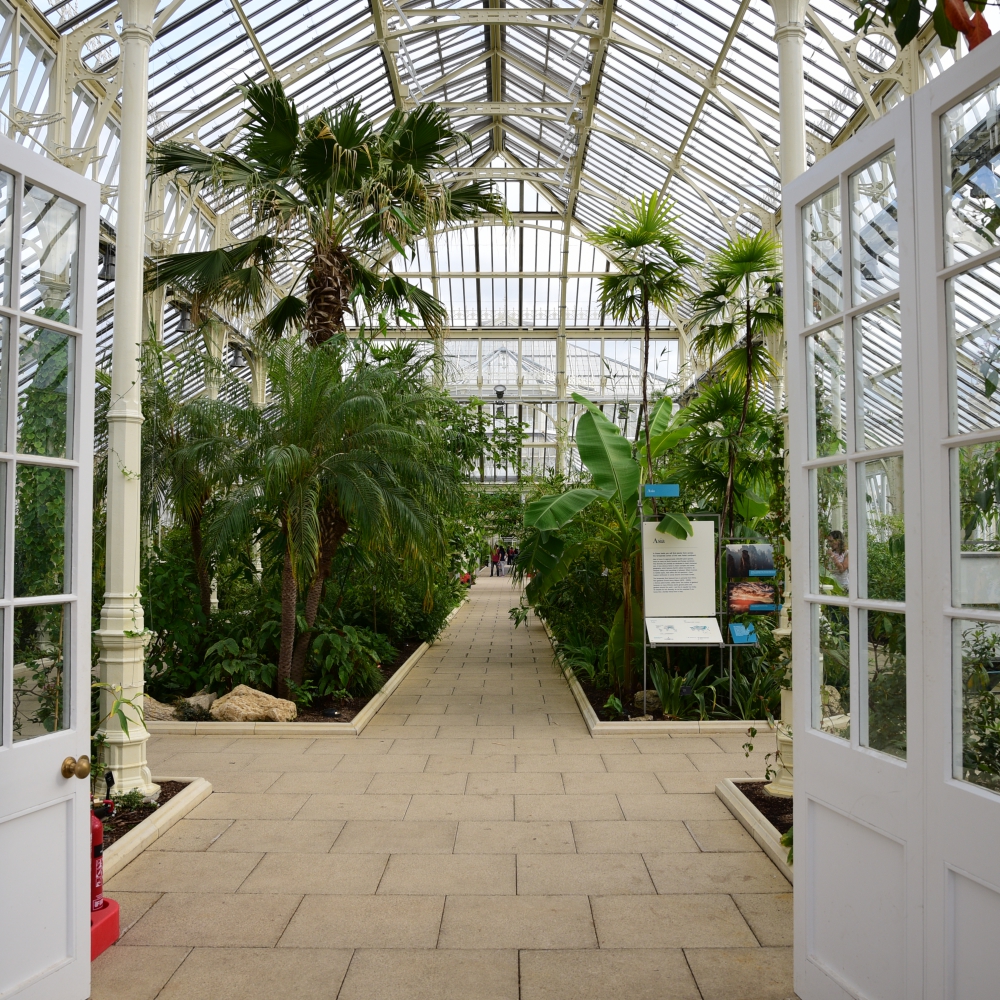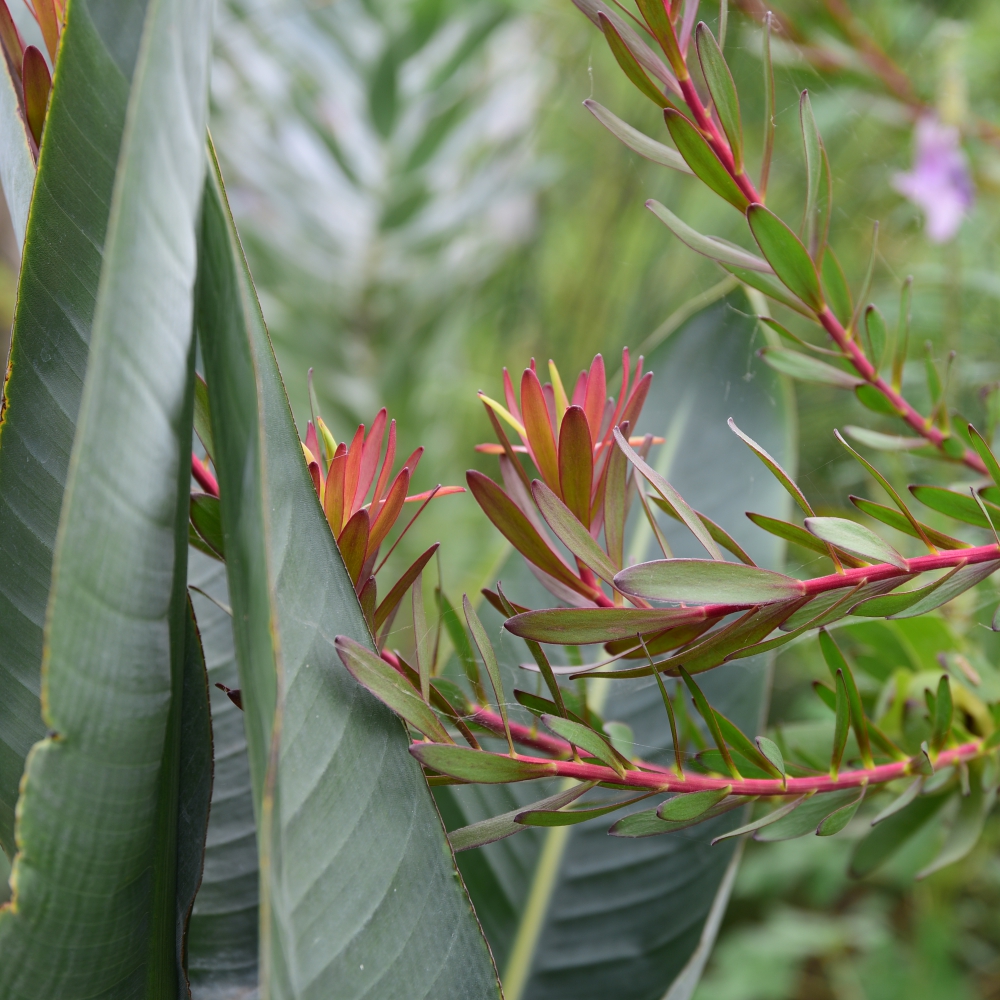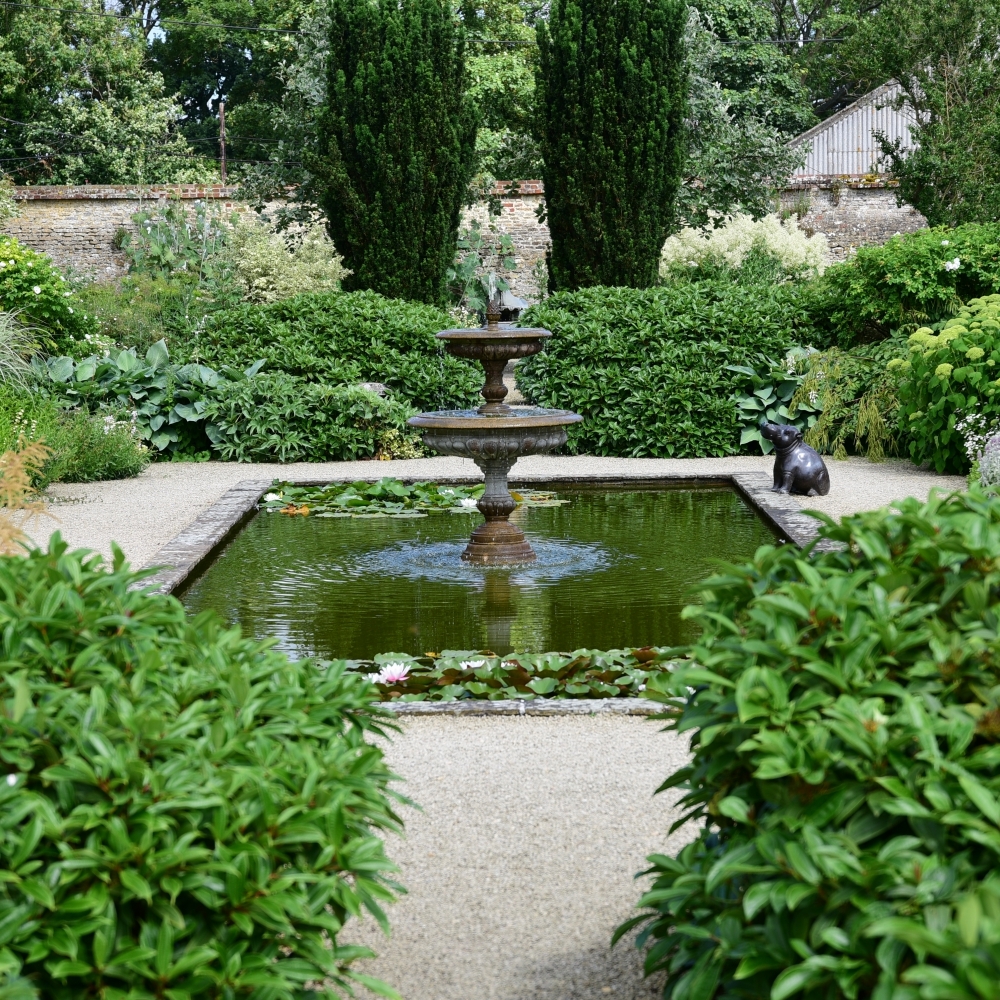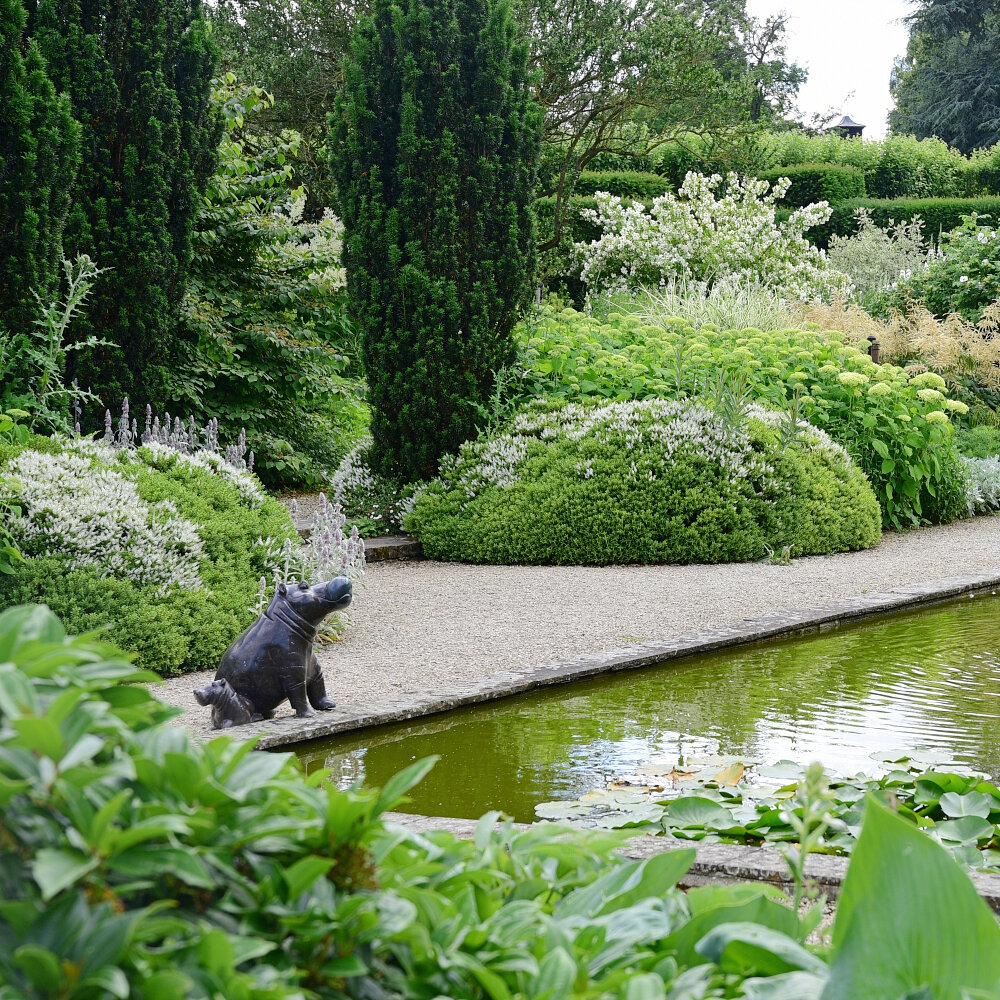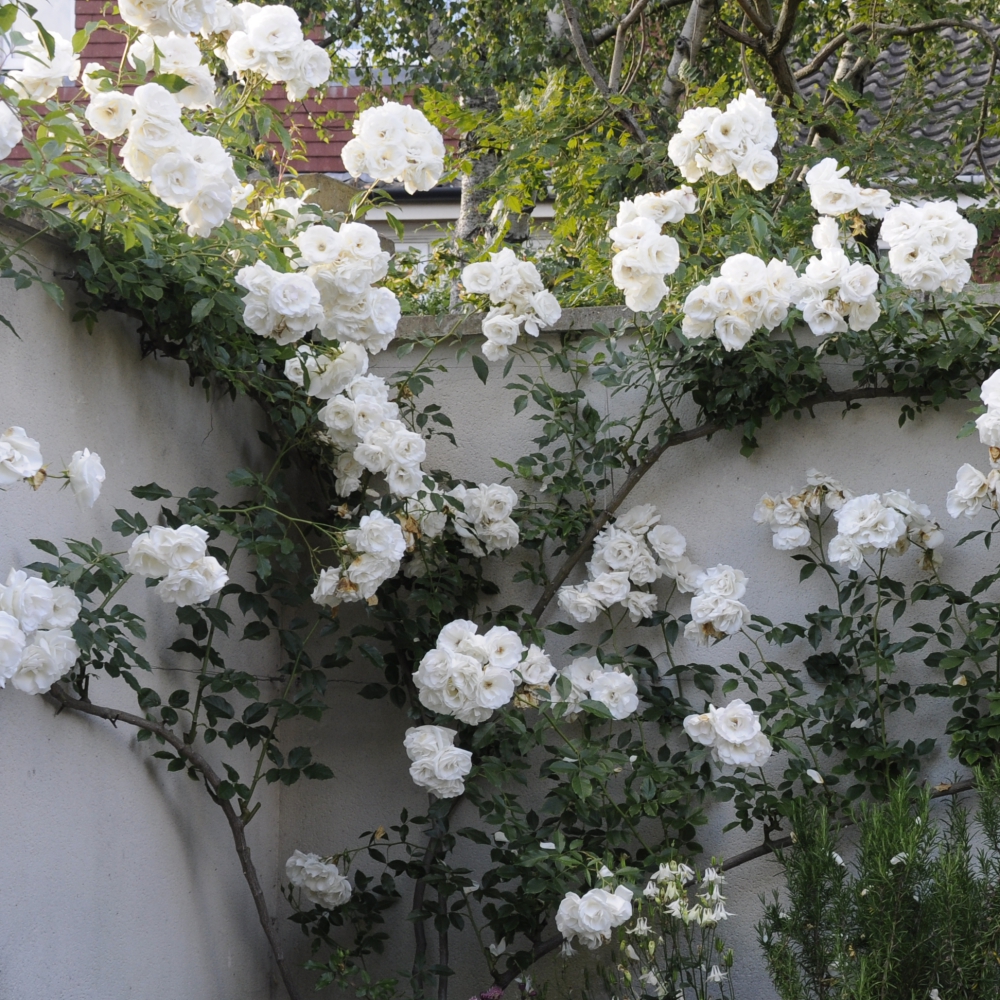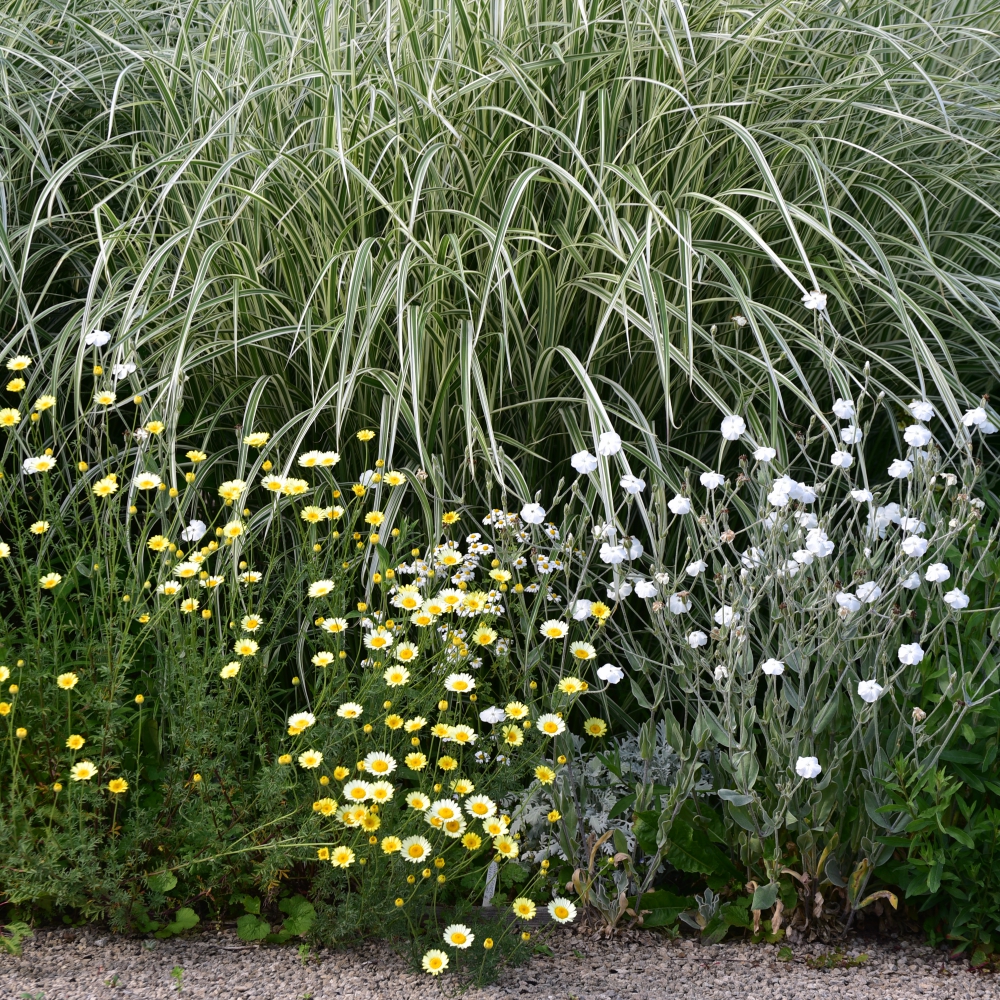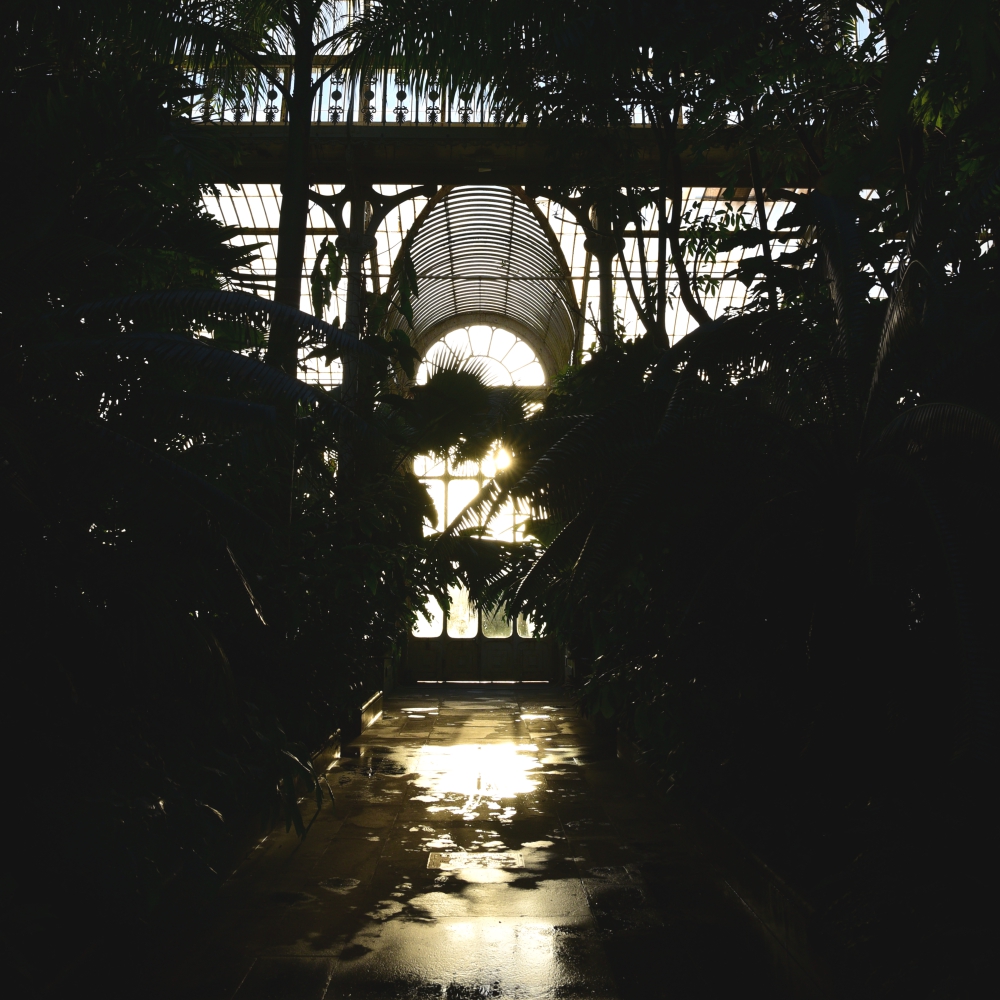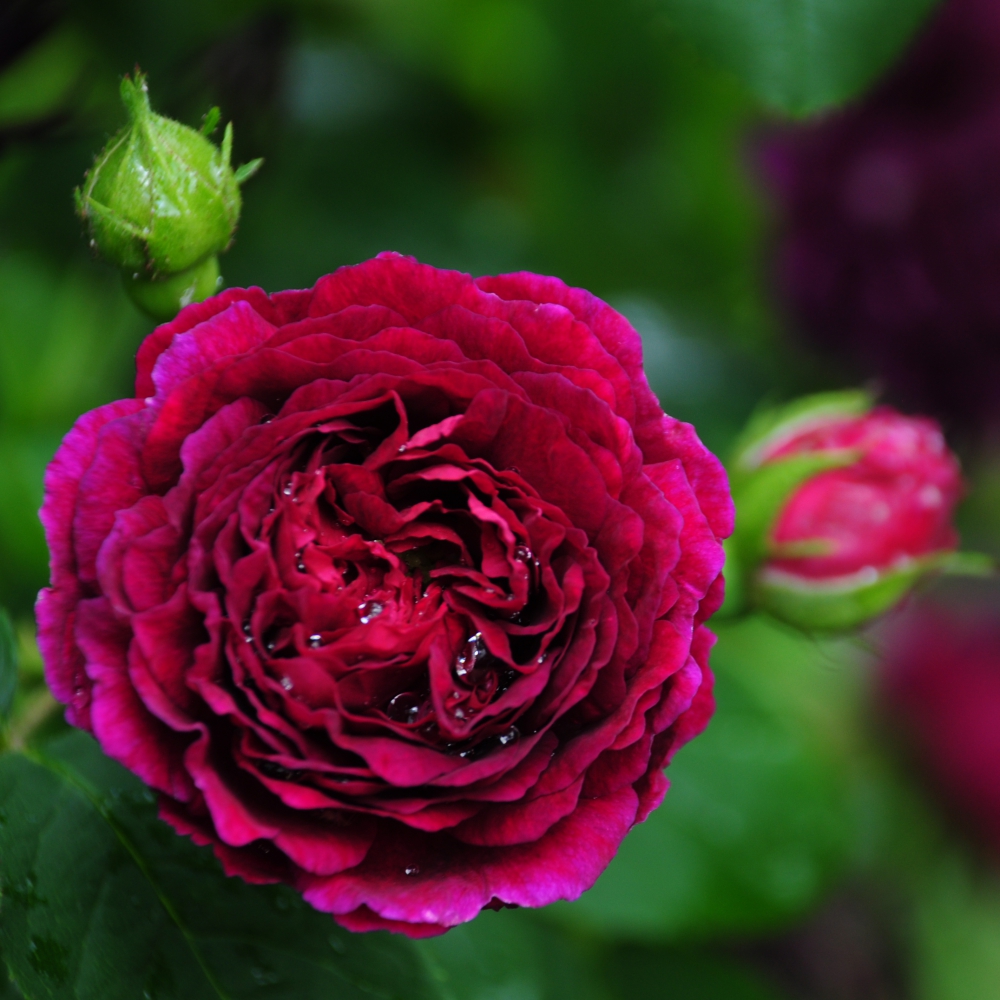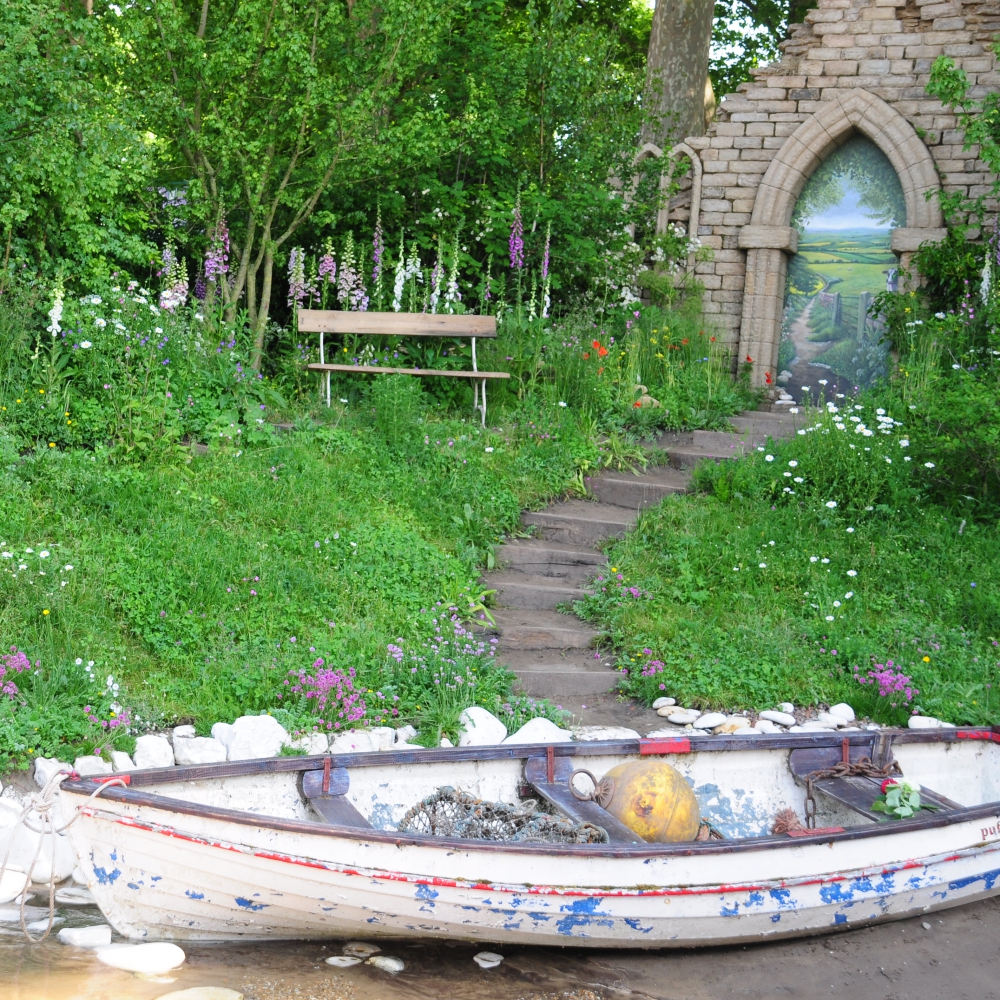The greatest show on earth
The Chelsea Flower Show for 2020 was an early victim of Coronavirus, leaving a bit of a hole in many peoples’ diaries. The RHS, like lots of organisations, is adapting and going online with a virtual flower show. To whet your appetite I’ve been though all my photos from 13 years of shows to bring you my favourite garden from each year.
2007
This garden designed by Laurie Chetwood and Patrick Collins was a surprise gold medal winner, not least because it featured a giant mechanical flower. Apart from that I thought the planting was delightful, particularly this mix of huge yew topiary and softer perennial planting.
If you thought this garden was controversial, Best in Show went to the 600 Days garden based on life on Mars…
2008
This year my favourite did win Best in Show. It’s designed by Tom Stuart-Smith, one of my favourite designers.
I think it’s still one of all-time favourite gardens, and lucky Tom got to take these infinity water troughs home.
2009
I’ve picked another Best in Show winner this year as well. This was Swedish designer Ulf Nordfjell’s second garden at Chelsea.
I loved the different uses of the same material - big chunks of rough-hewn granite, smooth, honed paving and granite chippings. All juxtaposed with the wild-looking planting. I’ve based at least one planting scheme on a similar palette of plants and I love using silver-grey granite paving.
2010
Oh no, another Tom Stuart-Smith garden. I wouldn’t mind sitting here for the duration of lockdown.
Best in Show went to another Chelsea perennial, Andy Sturgeon, for his Cancer Research garden. He was described as a “young turk”, ahhh.
2011
An administrative blip on the photo filing front means I can’t bring you a good-quality photo of my favourite garden in 2011. But let me tell you, it was Cleve West’s Best in Show garden based on an excavation of a Roman ruin. Remember the toppled coloumns, that mustard-coloured wall and the flower of the year, Dianthus carthusianorum? I’m still using that plant.
2012
At last I’ve chosen an Andy Sturgeon design. Cleve West won Best in Show for the second year running but I think it should really have gone to Andy Sturgeon. That’s my theory anyway..
The sculpture of rusty circles is fab. Oh to have a design budget to run to that sort of frivolity.
2013
And now for something completely different. It takes an Australian designer, in this case Philip Johnson, to produce an amazing garden of waterfalls and native flora.
2013 was the centenary year for the Chelsea Flower Show, and it was notable for some of the spats between a couple of designers and the judges. Some mollification was made by the introduction of a Peoples’ Award, won this year by Chris Beardshaw, and a subsequent increase in the transparency of judging.
2014
My choice this year is a bit of a marmite garden. It did win Best in Show for Luciano Guibbelei but wasn’t universally popular.
I think it’s because the garden was relatively minimalist for Chelsea. Also, in another attempt to shake things up a bit the RHS started to encourage more younger designers to enter the show. Hugo Bugg, at 27, became the youngest designer to win a gold medal.
2015
In the last five or six years there has been a big move towards wilder-looking gardens like James Basson’s Provencal garden. Best in Show went to Dan Pearson’s evocation of part of Chatsworth’s trout stream.
This trend isn’t universally popular and prompts the question of what is a garden? Is an evocation of a wild landscape a garden design? I’ll leave that one with you…
2016
Bucking the trend in more ways than one was Jo Thompson’s Chelsea Barracks Garden. Best in Show went to Andy Sturgeon’s geology inspired design but Jo’s garden was a refreshing change.
Manicured to within an inch of it’s life it was all sleek lines and planting perfection. You could smell the roses from 20 yards away.
2017
My choice here is another James Basson garden, this time an evocation of a Maltese quarry. The research into the native flora was meticulous, and getting and growing the plants required painstaking attention to detail.
I love the blocks of stone and wildflowers but again it wasn’t everyone’s cup of tea.
2018
This another year where I think the judges got it wrong. Best in Show went to Chris Beardshaw (finally) but I thought his garden was poorly laid out for visitors to be able to see. My favourite was Sarah Price’s Mediterranean garden.
Perhaps it was too similar to James Basson’s garden the previous year, but I thought the planting was fantastic. Unusually for a show garden there were no chairs.
2019
And finally to 2019. Yet again it’s another Andy Sturgeon garden. It was a popular winner of Best In Show but who can forget Mark Gregory’s canal garden, winner of the Peoples’ Choice?
It’s going to be interesting to see how the RHS will produce a virtual Chelsea, particularly when it comes to the show gardens. In the absence of the real thing I’ll be checking it out. How about you?
Hunte's Gardens
One of my favourite things about Hunte’s Gardens is the entrance. It’s a bit like stepping out the back of the wardrobe into a tropical Narnia (minus the talking animals). The lady taking your entrance fee emerges from behind a large palm and then melts away again.
I’ve been here a few times now and never tire of it. The gardens are the work of Anthony Hunte, with the assistance of five workers. He started from scratch in a sink hole on an old sugar plantation in 1990.
Steps wind their way down the sides of the sink hole. There are a couple of way points on the descent with seating and water features. Once at the bottom you are struck by the height of the Royal Palms, they have reached a mature height of around 25m.
In classic garden design style, only parts of the garden can be seen at once. Lots of paths lead you on round corners to private seating areas, giving you plenty of opportunities to sit back and listen to the pianist playing in Anthony’s house above.
Where the sides of the sink hole are too steep to plant they are festooned with creepers like this bearded fig, Ficus citrifolia. This is the tree from which it is believed the name Barbados came from.
The range of plants which can be grown here make any northern hemisphere gardener green with envy. Whilst we can grow hibiscus in the UK, they can’t compete in terms of size and colour with those grown in the tropics.
The gardens are decorated with many different water features, in particular large bowls filled with water lilies and lotus flowers. Orchids are dotted around like jewels.
I’ve always found it’s best to come here early, mainly to avoid a deluge of cruise passengers. Not all of them can manage the stairs however.
If you do visit Barbados on a cruise just hop in a cab and come straight here, by-passing visits to other gardens.
And don’t be put off by any rain, it’s much easier to take good photos when there’s no bright sunshine to contend with. And anyway, the rain never lasts long.
Refreshments are available and include Anthony’s infamous rum punch. A few gewgaws can also be bought here.
Even if you could get there, like pretty much everywhere at the moment, Hunte’s Gardens is closed until further notice.
Hunte’s Gardens doesn’t have a website but you can find them on Facebook and Trip Advisor.
Mottisfont Abbey Winter Garden
Review and photographs of Mottisfont NT Winter Garden design
Winter is not an obvious time to visit a garden, especially if it’s not even a nice frosty day. However, there are a smattering of winter gardens dotted around the country and Mottisfont in Hampshire is a notable example.
The Abbey was established in 1201 and made the most of it’s position on the pilgrimage route to Winchester, with travelers stopping off to marvel at the finger of St John the Baptist. Following the dissolution of the monasteries the abbey was not demolished but converted into a house.
The Winter Garden was established in 2010 and contains winter-flowering trees, shrubs, perennials and bulbs, many of which are highly scented.
Witch-hazels have the wierdest flowers, almost like strands of saffron. An unremarkable green-leaved shrub in summer, it is covered with these flowers ranging from pale yellow through to orange and a deep mahogany. They have a delicate citrussy scent and you need a still day to capture it.
It’s not just flowers that are brightly coloured, winter stems, bark and berries really come to the fore at this time of year. The standout features of the garden are the bright orange-yellow stems of Cornus sanguinea Midwinter Fire. This is another shrub that is pretty dull in summer but the bare stems, planted en masse, are really striking in winter. You need quite a bit of space to get this effect but it can be really worthwhile.
Many winter flowers like these Mahomia and winter honeysuckle, are attractive to pollinators, offering vital nectar on mild days when bees are flying.
The most fragrant shrub, and arguably the dullest to look at, is winter box or Sarcococcocca (I might have added too many cs and os…). It’s a shrub I use often in my garden designs as it is evergreen, has a neat habit, loves the shade and clay soil, and will stop you in your tracks on a winter’s day.
My parents tell me the walled rose garden here is pretty stunning in summer. At this time of year however, the other big attractions are the trees. There are some ancient mulberries and sweet chestnuts and a couple of absolutely enormous London Plane trees. One of these was planted in 1725 and measures more than 12m in girth. It’s not considered a “champion” tree as possibly it is two trees that have merged into one.
We only ventured into the house for coffee and cake. Surprisingly there was free cake, the chef was trying out some new recipes - the vegan hummingbird cake went down better than the salted caramel chocolate brownie - who’d have thought?
The gardens are open every day - https://www.nationaltrust.org.uk/mottisfont
A ray of sunshine
As 2019 draws to a close it’s a good time to look back at an eventful year. Eventful in the garden that is.
It’s been another year of unpredictable weather - drought and floods, and pestilence, but thankfully no plagues (unless you count the inexorable spread of Chalara, Oak Tree Processionary Moth, Box Tree Caterpillar). Thankfully, the virulent Xylella virus, responsible for the wholesale destruction of Italian, French and Spanish olive trees, has yet to reach these shores.
And still, we garden on. That gardening is good for you has finally reached the consciousness of millennials, mainly as a form of mindfulness. Something middle-aged people have been saying since the year dot…
The gardening year got off to a good start with a reunion with Sandy , Rae and Jo with whom I studied garden design. We’re all still practising, doing slightly different things so it was good to catch up and have a wander round Sandy’s lovely garden.
It was good to get away at the end of winter to a warm, sunny Barbados. I managed to miss most of the BHS open gardens but the sub-tropical climate means exotic plants grow like weeds, like this East-West Palm.
Much of 2019 has been taken up with one large project. The garden was only planted at the end of October so I won’t have any good photos until at least the spring of 2020. I was able to go back to a couple of projects that were completed in 2018 though.
E’s garden was a replanting project with a couple of minor landscaping adjustments.
Whilst J’s garden was a much bigger project. I always enjoy going back to look at completed projects, especially where the clients have taken good care of their gardens. And it’s a good opportunity to see which plants are doing particuarly well, especially if it’s the first time I’ve used them in a design.
There are two things I must do every May - visit a bluebell wood, this one’s in Berkshire, and go to the Chelsea Flower Show. The 2020 show’s got a lot to live up to but I hope the RHS will make it more accessible to the visiting public.
I was really busy through the summer and autumn which made visiting gardens difficult to fit in. One that I did enjoy though was the Green & Gorgeous Flower Farm in Oxfordshire.
It’s good to see the growth in British cut flowers, so much nicer and better than flown-in flowers. There’s also an increased interest in growing wild flowers. During a visit to my parents we went to see the wildflower meadow at The Vyne, it was stunning.
A slow burn project finally started to come together at the end of the summer. I’ve been looking after N’s garden for a few years but it did need a bit of a revamp. We reshaped the lawn and put in a lot of new plants. It will look even better next year but even by early autumn it was filling out.
This was the first time I’d used tree ferns, I don’t think it’ll be the last.
At the end of summer I had a few days in Suffolk. The heather on the heathland was in full bloom. I popped into Beth Chatto’s garden on the way home. Despite the hot dry summer it was looking really good, proof that her motto of right plant, right place always works.
The onset of autumn brought a trip to Scotland to see a friend’s new house on the edge of a Scot’s Pine forest.
And a return visit to the walled garden at Gordon Castle.
The last trip of the year was to the Peak District, staying in a friend’s lovely holiday cottage. It was very cold and foggy. Not great for a walk up Stanage Edge but excellent for a photographic ramble down Padley Gorge.
By the middle of December you’d think the year would be pretty much done and dusted. It is in the garden.
Gordon Castle Walled Garden
It’s been five years since my last visit to Gordon Castle. Quite a lot has changed since then. In 2014 the garden had only recently been designed by Arne Maynard.
The basic layout was in place with paths and borders outlined and most of the central vegetable beds were fully stocked and ready for harvest. Some of the earthworks were in place but hadn’t been grassed over. For such a huge garden it looked like there was still an enormous amount to do.
Clearly the gardeners have been busy.
The garden is huge, 200m x 200m, and must have required a an enormous number of staff to keep it going in its heyday. Following the second world war the lack of manpower meant the garden had to be turned over to less intensive agriculture and in the 1950s it was mostly used for growing raspberries commercially.
A restoration programme was begun in 2013 and now the garden employs some 65 people. Clearly some features such as the pear tunnels and grassy mounds will take some time to mature, but the fruit and vegetables and cutting garden areas are thriving.
Even in October there was still lot to see. Although all the fruit from the 249 veteran espaliered fruit trees had been picked some of it was for sale.
The garden supplies produce to the cafe. As garden cafes go this one is excellent and a visit to the cafe gives you a discount for entry to the garden.
A visit to a good garden late in the year gives you a good idea of what will do well locally. The walls here create something of a mini micro-climate allowing a longer than expected growing season. Although in London Dahlias, Gaura and Anthemis might still be in flower this late, Ammi visnaga probably isn’t.
The garden is open all year, pretty much everyday. The cafe is worth a visit on its own, it has not one but two log burners. I imagine they’re both needed in winter. The castle itself is not open to visitors.
If you’re the hunting, shooting, fishing type there’s lots for you here.
Gordon Castle Walled Garden https://www.gordoncastle.co.uk/garden/
The Beth Chatto Gardens
It’s 18 months since influential gardener Beth Chatto died at the ripe old age of 94 (proof once again that gardening is good for you). It all started in 1960 when she and her husband Andrew built a house on an unpromising corner of land on his fruit farm.
Beth Chatto’s garden covered an area of boggy ditches and scrubland and, as the garden is in one of the driest corners of the country, she became adept at choosing the right plants for the right place, an approach that is very much taken for granted now.
The woodland garden was created in the aftermath of the great storm of 1987 when many trees were blown down. Beth made a new garden with shade-loving plants to carpet the floor and groups of shrubs to create micro-climates for flowers and bulbs.
Her book “Beth Chatto’s Woodland Garden” has become a valuable resource to me when tackling difficult shady areas in London gardens.
Finding clover used as a ground cover in the woodland garden was something of a surprise. I’m so used to thinking of it as a weed it was lovely to see it used in this way.
Making a virtue of a more profound problem in her garden lead to Beth creating a gravel garden and a scree garden. She was determined to prove that by choosing the right plant it would not be necessary to water the garden.
Ahead of her time, once again, Beth chose plants that required minimal amounts of water that would thrive in her stony and poorly nourished soil. Another book, “Beth Chatto’s Gravel Garden” documents the development of the garden. Many of the plants are of Mediterranean origin.
This book is slightly less useful in London gardens with heavy clay soil, but great for my parents gardening on almost pure gravel.
I visited on a blisteringly hot day in August (remember those?) and feeling somewhat parched I headed for the cafe. It was disappointing to see long queues for food and drink so I headed off to the nursery in a somewhat grumpy mood.
This is probably the best retail nursery I’ve ever seen. The plants were grouped according to the conditions they liked and displays showed how they could work together. So much more useful than putting plants in alphabetical order which makes no sense to anyone other than an untrained shop assistant who has no idea what they’re doing.
And if you can’t face a trek out to Colchester they have a really good online shop which I’ve used many times. It’s much better than other fancy online retailers with glossy websites and/or glossy catalogues, and usually quite a bit cheaper too.
Hats off to Julia Boulton for keeping up and developing her grandmother’s work.
The Beth Chatto Gardens - https://www.bethchatto.co.uk
Beth Chatto’s Gravel Garden and Beth Chatto’s Woodland Garden are no longer in print but they have been replaced by Drought Resistant Planting and Beth Chatto’s Shade Garden, both still written by Beth Chatto.
The Vyne's Wildflower Garden
The wildflower meadow in the walled garden at The Vyne was born out of need rather than just desirability - there just weren’t enough pollinators to go round. And we all know now that pollinators are needed not just for flowers but for a most of our fruit and vegetables as well.
This is the first year of the planting which is a mixture of annuals and perennials. They are all grown from seed, some sown in situ and others started in the greenhouse and planted out once they’d grown on a bit.
I saw them at the end of July and they looked fantastic. My mother told me they looked even better a couple of weeks earlier but it’s hard to see how. They’ve even stood up well in the record-breaking temperatures of mid-July and the subsequent heavy downpours.
Flowers attract pollinators by offering them pollen and nectar in exchange for fertilisation by travelling from flower to flower. Specific flower types are rich in one or the other or both, and some flowers offer nothing.
Very generally speaking the closer a flower is to its wild beginnings the better it is for nectar and pollen, which is why wildflowers are so beneficial. However, there are also lots of more cultivated varieties which still have something to offer.
Poppies and cornflowers are native wildflowers and pollinators love them. But they also like snapdragons, cosmos and marigolds, none of which are native to the UK. Different shaped flowers attract different types of pollinators; there's a good explanation here - https://www.foxleas.com/flower-shapes.asp.
Flower colour also has a role to play in attracting pollinators. It’s well-known that bright blue flowers attract honeybees and other species have preferences for other colours and scent as well; the scientific research can be read here - https://www.nature.com/articles/srep24408.
Of course we’ve got used to knowing which wildflowers are at their best in high summer, but spring, autumn and even some winter flowering plants are just as important for pollinators - https://www.gardenersworld.com/plants/10-plants-to-help-bees-through-winter-into-spring/.
Although all pollinators are good for our crops and flowers, some are more equal than others. The honeybee can pollinate 80% of our flowers, fruit and vegetables. And almost all honeybees are domesticated, ie they live in hives.
The plight of the British honeybee has been well documented in recent years but the popularity of bee-keeping is helping to check and even reverse this trend. If you’re attracted to the idea of keeping bees get in touch with the British Beekeepers Association - https://www.bbka.org.uk/Pages/Category/what-we-do.
We arrived at The Vyne shortly after opening and I recommend going early to avoid the crowds. The coffee’s not bad and the queue is manageable earlier in the day. However, you do risk the icecream shop not being open…
Despite growing up near here I’ve never been in the house.
The Vyne - https://www.nationaltrust.org.uk/the-vyne
Buy wildflower seeds online - https://wildseed.co.uk/
Green & Gorgeous Flower Farm
I found out about Green & Gorgeous in a magazine and paid a visit on a Saturday late in June. It was a blisteringly hot and eyeball achingly bright day. Not ideal for photography but hey it was a bit of a trek to get there so I had to make the best of it.
On arrival I was sent off to the sweet pea borders. If ever there was proof that if you’re going to do sweet peas properly you’ve got to plant an awful lot of them then this was it. I could smell them before I could see them. Unfortunately my photos of the sweet peas weren’t very good but if you scratch your screen here you can smell them.
Although the main business here is growing flowers for cutting, particularly in summer in full wedding season, Green & Gorgeous is open on Saturdays for you to pick your own sweet peas and select just-picked stems and produce in the shop. Some perennials are also on sale.
I asked if they minded me taking photos and they didn’t so off I wandered. It was a very pleasant way to spend an hour or so, it was just a shame there wasn’t really anywhere to have coffee. Maybe there was but the poor lady in the shop was on her own and I didn’t have the heart to ask as she was pretty run off her feet.
As well as creating floral bouquets for events they also run courses on topics ranging from how to set up and run a flower farm business to flower arranging, and garden photography with Eva Nemeth.
The photography on their website is lovely and the Instagram feed is pretty impressive too. It was great to see a successful business selling local, seasonal produce that doesn’t have a huge carbon footprint.
For those of you desperate for a coffee or other refreshments there’s plenty on offer in nearby Wallingford or Goring & Streatley (if you can find somewhere to park).
Green & Gorgeous - https://www.greenandgorgeousflowers.co.uk
Did anyone scratch?
Chelsea 2019 - All the world's a stage
More than once Mark Gregory, winner of The Peoples’ Award at this year’s Chelsea Flower Show, said that all of Chelsea was about the theatre, the spectacle and putting on a show. And, as yet again, people ask “what is a garden?”, isn’t it time to stop worrying about definitions and practicality and just enjoy the performance?
Of course the market for a canal-based garden design is very niche but the Peoples’ Award showed that the visiting and viewing public at Chelsea loved this show garden. And why is that? There’s the sheer ambition of building something as monumental as this and then the artistry of making it look like it’s always been there. And finally, the romance of the wild-meets-cottage-garden planting. As a piece of escapism it couldn’t be beaten, just like watching an episode of Downton Abbey at the end of a good weekend.
Every garden at Chelsea needs a bit of drama, just so that we sit up and pay attention. Who can deny the unexpected fabulousness of these black oak spines running through Andy Sturgeon’s garden?
Or the bright red bridge in Jonathon Snow’s Trailfinders garden? Much better in real life than on tv.
However, one significant intervention is not neccesarily enough if the rest of the design can’t match it. The rather lovely David Harber sculpture was not enough to carry the rest of Andrew Duff’s somewhat lacklustre design.
Not all the drama is man-made, as Chris Beardshaw showed with his charismatic Pinus nigra which cut an unruly dash across his otherwise impeccable garden.
And of course, it’s important to make sure the garden isn’t all drama with no plot or character. It’s a fine balance, do you think Sarah Eberle pulled it off? The judges thought so.
As for the rest of the show gardens on Main Avenue, it wasn’t always possible to tell if there was any drama or not, if there was it was hidden away. In the case of Jo Thompson’s Wedgwood garden it was hidden in the shadows behind all the pillars and in Kate Gould’s Greenfingers garden it was either hidden in the sunken bit or on the roof. Maybe you could see it on tv but you couldn’t see it in the flesh. And as for the Duchess of Cambridge’s Back to Nature garden you could only see if you were prepared to wait in a very long queue and I’m afraid I wasn’t.
Helen Elk-Smith’s design for Warners Distillery seemed to focus on product placement (bottles of gin liberally spread across the garden, but just out of reach of the viewing public) and kept the dramatic falls of water fairly well hidden. The tv cameras did a lovely job of picking them all out, particularly when lit at night, but many of them were hard to see with the naked eye from 10 metres away.
And finally, sometimes the drama is not about the big idea but all about the small dramas played out in the foreground, like the interactions of the very fine planting in Tom Hoblyn’s garden. It may not be quite what he intended but sometimes it’s the minor characters that steal the show.
As ever, there were long queues for everything at Chelsea but at least the line for the ladies loos was fast-moving. It was crowded, the food and drink were expensive, but would I go again? Oh yes..
The Homewood
The Homewood is a modernist house by the architect Patrick Gwynne. He was just 23 when he designed the house for his parents in 1938. Luckily for him they already owned a Victorian villa on the 10 acre estate just outside Esher in Surrey.
In another stroke of luck, his parents were able to sell a small town in Wales to pay for it. As anyone who's ever house-hunted in Surrey knows that's what it takes to secure a small bit of real estate here, then and now.
The Victorian villa was demolished and the new house located to make the most of the views of the garden, and views of the house from the garden. Patrick Gwynne lived here most of his life and left the house to the National Trust.
Gwynne made some updates to the house throughout his life but kept fairly true to his original vision. In the garden, this terrace was added in the 1970s, not an era particularly respected for its contribution to garden design (maybe concrete paving will make a comeback...?).
The angular swimming pool is a success though, and is still in use by the current tenants. The water is crystal clear, illuminating the green tiles. The later addition of a curvilinear pond with bright blue tiles doesn't work as well.
Just glimpsed from the house is a series of ponds. Gwynne was able to dam a tributary of the River Mole to create these reflecting pools and a bog garden.
The garden guide pointed out that a condition of National Trust ownership is that every garden should have a Gunnera manicata. I'm inclined to believe he wasn't joking.
Following the construction of the house some editing of the garden was carried out, with a few trees being removed or having their lower limbs pruned, to improve the views. Some of the tree stumps are used as sculptural pieces in the garden.
This part of Surrey is known for its sandy, acidic soil and this is reflected in the planting - lots of heather, pines, Japanese maples and silver birch trees.
It was Gwynne's aim to blur the boundaries between the garden and the relative wilderness of neighbouring Esher Common. Gwynne's ashes are scattered in this part of the garden.
To see the garden you have to book a house tour. The house is only open to visitors one day a week for a few months a year so you need to be organised.
A short garden tour is also on offer after the house tour. Be warned though, if you are booked on the last house tour of the day there is not much time to see the garden properly.
I was hoping to sneak round the back of the ponds get to get a photograph of the house reflected in the water but was chased down by the guide and asked to leave - this was disappointing to put it mildly.
The house was really interesting and fans of mid-century modernism would not be disappointed. The garden was much better than I expected so it was shame not to be able to spend more time in it. It would be good visit in spring when the Rhododendrons are in flower, or in October when the heather is in flower and the Japanese maples are changing colour.
You can't take any photos inside the house but you can see some here -
http://egondesign.co.uk/my-dream-home/
There are no facilities (tea, cake or loos) here but Claremont is nearby and the cream tea is excellent (thankyou Desna).
The Temperate House at Kew
The last time I was at Kew the Temperate House was still being renovated. It reopened in July after a five year restoration project.
Like The Palm House, it was designed by Decimus Burton and opened to the public in 1863. The Temperate House is twice the size of its neighbour and is the largest Victorian glasshouse in the world.
As the temperate zone is where most of the world's population lives many of the plants here face the combined threats from climate change and human population growth.
Indeed The Temperate House contains the only known living specimens of some plants. Like Encephalartos woodii, a cycad from South Africa. Only one has been found in the wild and an offshoot was sent to Kew in 1899. It is a male and no females have ever been found.
The Temperate House is divided into zones representing Australia, New Zealand, the Americas, Asia, Africa, the Himalayas and 16 islands. Many of the species housed represent human, animal and insect food, garden plants, plants with cultural uses, plants used in building, manufacturing and medicine. Kew safeguards their future by banking the seed at its Millennium Seed Bank in West Sussex.
The light in The Temperate House is beautiful. On a sunny day the shadows from the structure run across the leaves and paving. As the plants grow this will probably become less of a feature. For now though it looks very modern, if only more conservatories looked a bit like this.
As part of the renovation there has been an effort to make the glasshouse more of an experience than just a scientific collection, with a waterfall and a dramatic collection of tree ferns running along a dry riverbed.
The Temperate House contains plants not quite hardy enough to survive an English winter. However, I think with the right care and location in your garden, in London you might risk planting tree ferns. The false banana, Ensete ventricosum below, and exotic gingerlilies, would defintely need to be brought inside though. That's fine if you've got somewhere suitable to house it, otherwise best leave it to Monty Don.
To truly appreciate the splendour of the architecture you can climb the spiral stairs to the gallery and get a view of the central area.
I look forward to seeing how the planting develops. It's almost worth the £17 entry fee to Kew Gardens on its own.
The Temperate House - https://www.kew.org/kew-gardens/attractions/temperate-house
Loseley Park
Loseley Park, home of the eponymous icecream, has been lived in by the More-Molyneux family for over 500 years. The house, set in 400 acres in Surrey, was built in the 1560s. Its walled garden was set out in the 16th century, re-designed by Gertrude Jeckyll in the 19th century and was redesigned again in 1991.
Of course there's a rose garden, with over 1,000 roses, and a vegetable and cut flower garden.
But in high summer it's the various flower gardens that really grab your attention. The Flower Garden is designed with hot colours in mind, but these only develop in late summer. Now there is a tasteful palette of blue and yellow.
I like the way the plants are packed in, those with looser structures like Geranium pratense and Cephalaria gigantea scramble through evergreen Buxus and Euphorbia, with the frothy Alchemilla mollis skirting the floor.
Sissinghurst is not the only white garden in the country. The one at Loseley Park is based around a tranquil pond. It's no surprise this is a popular place for weddings.
One of the things you notice about the White Garden is that not all the plants are white. There are creams, silver, pale yellows, pale pink, dark greens and plenty of variegated leaves.
One of the more unusual features at Loseley Park is the moat. It's not clear what function it has served but it's now planted with water lillies and Gunnera and home to at least one mallard family with no less than seven ducklings.
From the moat there's a short walk through the Rose Garden. At the end of June most of the roses are in full bloom. There was a sculpture display there when I visited. The overall impression was marred somewhat by the sorry-looking box hedge. I couldn't tell what was causing the problem but they have my sympathies, it's getting harder and harder to keep box looking good.
The Tennis Court Border would have been easy to miss as it's a bit out of the way.
Again there's a blue and yellow theme here, with the full range of Verbascums, from the statuesque V. bombyceferum to the more delicate V. chaixii. It can't all be in good taste though as these poppies were unlikely to have been blue or yellow.
The stone walls make an attractive backdrop. I was surprised there weren't more climbers in the garden. There is a magnificent and ancient Wisteria but it was obviously not in flower now. There are a couple of roses but really there is the potential for so much more.
There are tea rooms aplenty here but unlike these two I didn't have time even to taste the icecream let alone sit down.
Loseley Park - http://www.loseleypark.co.uk/
You need to plan your visit. There is a tedious diversion in place to get there until the end of July 2018, and the house and gardens are not open on Fridays or Saturdays.
How to make a white garden
If you've been inspired by the white garden at Loseley Park or Sissinghurst or just by the idea this will help you plan one.
First off, you've got to be committed. There's no point going 95% of the way and then throwing in a magnificently lurid Dahlia you've seen on Gardener's World or The Daily Telegraph.
Next, you need some strong, structural evergreens. Nothing sets off white flowers like dark green. And it's good to have some structure in the winter and to form a backbone to the garden. At Loseley Park they've used Viburnum davidii. It doesn't get too large and keeps a nice shape. You could also use Buxus sempervirens (box) or Taxus baccata (yew).
Something tall and willowy at the back of the border will add some height. Veronicastrum virginicum Album would fit the bill, as would Epilobium angustifolium Album or Digitalis purpurea Alba which would be good for a slightly shady border.
Working your way forwards, Anemone x hybrida Honorine Jobert is a reliable late summer flowerer. It can take a while to get going but its wiry stems will weave their way through other foliage.
One of the things you'll have noticed about most white gardens is that they are seldom all white. Touches of pale pink, grey and pale yellow add some depth to the scheme. This Allium Decipiens does just that with globes of the palest pink in late spring. Other pale pinks to think about include the fluffy spikes of Stachys byzantina and Linaria purpurea Canon Went with its delicate spires.
If you're lucky enough to have a good wall or fence don't forget about adding in some climbers - Rosa Iceberg flowers on and off all summer. And Tachelospermum jasminoides does several jobs - it's evergreen and produces masses of scented white flowers in July. Try a clematis to get an early start such as Clematis montana Henryi.
Variegated foliage is frequently used in white gardens and this Miscanthus sinensis Varigatus adds movement in a slight breeze, some structure through the winter and works really well with the pale yellow Anthemis tinctoria Sauce Hollandaise and the white flowers and grey stems of Lychnis coronaria Alba.
Other variegated foliage plants to consider are Cornus Elegantissima, Pittosporum tenuifolium Golf Ball and Euonymus fortuneii Emerald Gaiety. Do check the ultimate size of the plants before buying ...
You want to get the white garden off to an early start so bulbs are a must. My favourite, Tulipa Spring Green looks great with Narcissus Thalia or N. Actaea. Other white tulips include T. White Triumphator and T. Tacoma.
Following hot on their heels are Astrantia major Large White, liking not too much sun and a bit of dampness. Astrantia major Buckland has a slight pink tinge. You'll need to plant a few of these fairly close as they take some time to fill out, worth the wait I think.
And finally, if you're after an end of season show stopper then it's got to be a hydrangea. This one's H. Emilie Mouillere which fades to a lovely pink colour. Another favourite is H. arborescens Annabelle with enormous green/white flowerheads if it gets enough water.
If you've not the space for a hydrangea this is the point at which you can add in a Daily Telegraph dahlia, but make it D. White Star or D. Lady Kate or D. Bishop of Dover.
One thing to remember about white gardens, charming as they are, if you don't dead head regularly it will all look rather brown and ugly as the flowers fade.
Lukesland Gardens
I feel very lucky to have friends with friends with amazing gardens. Last weekend I stayed with John and Lorna Howell, owners of Lukesland in Devon.
The garden covers around 26 acres of woodland, streams, arboreta (there's more than one), rhododendrons, azaleas, wild flowers and a kitchen garden.
The garden was started by the Matthews family in the 1860s, followed by the McAndrews in the 1870s, but has been tended to and developed by the Howell family since the 1930s.
The garden has become known for some of its "Champion" trees, which means they are the oldest, tallest or with the largest girth in the county or country. The high level of rainfall, acidic soil and mildish climate makes it ideal for Camellias, Rhododendrons, Azaleas and Magnolias.
.I was told the Rhododendrons were past their best by the end of May but they still looked pretty good to me. However, this is prime Azalea flowering time, the reflections in some of the ponds were particularly stunning, better than the Isabella Plantation I think.
For me the streams and ponds are the highlight of the gardens. Addicombe Brook tumbles through the garden over cascades and Dartmoor granite rocks. It's not without hazard though as floods in recent years have washed away paths, bridges and sculpture and silted up ponds. They've been rebuilt and restored and you'd never know there'd been such devastation.
The wild flowers are also particularly attractive. There are bluebells in the Beech wood and in the Pinetum where they flower in the open with grasses, and along the stream with Red Campion.
The dampness means plants like Iris sibirica, asiatic Primulas, Gunnera and ferns thrive here, as well as some of the trees like the giant coastal Redwoods from the USA.
Lukesland is particularly well known for its three large Davidia involucrata, also known as the Hankerchief Tree, which were flowering during my visit. Unfortunately none of my photos could do them justice but if you're in the area in late spring seeing them is worth a visit on their own.
Although the tea room was busy (and yes I can recommend all the cakes as I tried most of them whilst serving the tea...) the gardens are so large it's easy to find a quiet spot to yourself.
One of the advantages of staying overnight is the opportunity to get up at the crack of dawn and wander around on your own, although the weather conspired against me and I didn't quite get the mist and low sunlight I was hoping for. Next time maybe...
The gardens are only open in the spring and then again in the autumn as the foliage of the Rhododendrons, Azaleas and Acers is stunning I'm told.
This garden is maintained by Lorna and John, John's mother Rosemary (who runs the guided tours) and three very part-time gardeners. Hats off to them all.
Lukesland - http://www.lukesland.co.uk/Index.htm
You can rent a cottage in the grounds - https://www.helpfulholidays.co.uk/cottage/Devon-East-Anstey/The-Clock-House-976251.html
Many thanks to John and Lorna and Rosemary and Desna (and Rob..).
The Wisley Glasshouse
Spring feels a long time coming this year. Even the daffodils seem a bit shy, hardly surprising considering how cold, wet and snowy it's been. Best to get indoors and explore one of our great glasshouses.
Designed and built some 150 years after the great Palm House at Kew there are similarities in the design and feel at the Wisley Glasshouse. It covers three climatic zones - tropical, moist temperate and dry temperate.
The topical zone features many of the same plants as at Kew, although in a format that's probably more fun to explore for children (of which there were many...).
There are palms aplenty, including this statuesque Bismarkia Palm from Madagasgar and large banana palm, Musa thomsonii. I love how they look against the light.
The moist temperate zone is kept in a range of 8-12 degrees Celsius. Orchids abound in this zone, including this Cymbidium Ayres Rock,
and, hilariously, this Oxalis which many gardeners will recognise as a rather persistent weed. However, it does look attractive here.
Many of the plants in this zone will grow in very sheltered parts of the UK, Cornwall for example or in a cool conservatory. The main requirement is that the environment remains frost-free.
If you've got the right environment and you're up for a challenge then this beautiful Lochroma grandiflora "Blue angel's trumpet" would be a spectacular attraction.
The dry temperate zone is home to many succulents and cacti, a must-see if you've caught on to the current the house-plant trend. Plants here come from places as far apart as Chile, Australia and the Canaries.
One of my favourite plants here is the amazing King Protea from South Africa. Virtually impossible to grow outside in this country but varieties are usually available from florists. The glaucus foliage of this Leucadendron Red Dwarf looks good with it.
Cacti are relatively easy to grow indoors. Slow-growing and long-lived, they prefer to be left alone rather than pampered. Be careful where you place them though...
Entry to RHS Wisley is a rather hefty £15.50 so try and make sure there's enough going on to make it worth your while.
The tea was good, albeit in a bucket-sized paper cup, and the chocolate fudge cake was worth the calories.
RHS Wisley - https://www.rhs.org.uk/gardens/wisley
Want to get into houseplants? - http://www.janeperrone.com/
The Palm House at Kew
A full six days after getting off the plane from Barbados I found myself in the tropical Palm House at Kew Gardens. It's some years since I've been in here and now with a little more knowledge (but not much more) I enjoyed the heat and atmosphere, complete with song birds (well, a robin).
The Grade I listed Palm House was built in 1844, designed not by Joseph Paxton as I'd always thought, but by Decimus Burton. It was built specifically for tropical plants brought back by Victorian plant hunters. The glasshouse is thought to resemble the upturned hull of a ship and indeed some ship-building techniques were used in its construction.
"The Palm House recreates a rainforest climate, a living laboratory supporting a diversity of plants from the tropical regions of the world, all under one roof. The plantings simulate this multilayered habitat, with canopy palms and other trees, climbers and epiphytes down to the shorter understorey plants and dwarf palms. Many plants in this collection are endangered in the wild, some even extinct. There are many species here studied by Kew scientists for research into medicines."
There are plants aplenty here that grow in the Caribbean - bananas, plantains, hibiscus, gingers, more palms than you can shake a stick at, plus coconuts and sugar cane. And from the far east, orchids and spices - pepper, vanilla, and the "Marmite" plant - bamboo. From Australia there are macadamias, from South America Brazil nuts.
As a garden designer the main attraction of tropical plants is their sheer exhuberance - the rate at which they grow due to high levels of light and moisture, the varied size, shape and texture of their foliage and (usually, though not at this time of year in this country it seems) the bright colours of their flowers.
The quality of light, particularly how bright sunshine (on a March day) filters through the foliage is rather fab, creating strong archtectural shadows and a green, almost underwater atmosphere.
The planting wouldn't appear anywhere as spectacular were it not for the architecture of the Palm House itself. It may look like an upturned hull from the outside but on the inside there's more than a whiff of Paddington Station.
The soaring arches and seemingly impossibly narrow ribs of wrought iron create and ornate backdrop to the plants.
And, as many people know, I can't resist a bit of rust, patina and condensation. The maintenance of the building must be a costly and time-consuming exercise. Is this why the entrance fee to Kew Gardens is £17?
Although the original design was reined in somewhat there are the customary Victorian flourishes showcasing what could be achieved for this new method of manufacturing iron.
The curved ceilings are designed to capture the maximum levels of sunshine. Only later was it realised that many tropical plants prefer shade and dappled light so manganese oxide-free glass, tinted green with copper oxide was installed to diffuse solar gain and approximate the light conditions in a tropical forest.
On a sunny spring afternoon the sun was setting directly behind The Palm House, creating spectacular shadows and from the outside the whole glasshouse looked illuminated.
The Royal Botanic Gardens, Kew - https://www.kew.org/
To read more about the design and construction of The Palm House - http://www.engineering-timelines.com/scripts/engineeringItem.asp?id=97
2018 - A good year?
Is 2018 - a good year to remember, or not? Maybe not for some reasons, but, politics aside, ignoring natural and man-made disasters, bad tempers and bad news in general, here is the good news round up of 2018 in the small corner of the world occupied by Arthur Road Landscapes.
A new year, a new day and a new camera on the beautiful island of Barbados. Not too much in the way or horticulture here but when the landscape looks like this who needs a garden?
But of course I couldn’t resist another visit to Hunte’s Gardens.
Having cleverly avoided the Beast from the East, but running full pelt into the Mini-beast, I made a beeline for the Palm House at Kew for a bit of warmth and humidity.
The cold winter and the sudden arrival of a very warm, but late, spring (who knew what was to come?) meant a very good year for bluebells. This little woodland of oak and ash was discovered by my parents in deepest Berkshire.
May means Chelsea. This was my favourite garden, by Sarah Price. Not everyone’s cup of tea, but definitely mine, I’m just waiting for a commission for somewhere in the Med…
At the end of May I visited Lukesland on the edge of Dartmoor. Spring was a little later here so this Wisteria was still in its full glory.
June sees the climax of our native wild flowers. Driving around Surrey I love the road side verges covered primarily in ox-eye daisies. Parts of the M25 are quite spectacular, something to enjoy whilst sitting out a traffic jam. It’s quite tricky finding somewhere to park and photograph them (I haven’t stopped to take any photos on the M25 I hasten to add).
The heat wave started around the middle of June I seem to remember. I went to Loseley Park before the weather began to take its toll and the White Garden here was looking splendid. Of course the thing about white gardens is that they’re not completely white.
July and August seem to have been swallowed up in a blaze of sweltering heat and guilt about using a hosepipe (sorry/not sorry) but at the end of summer I went to The Homewood in Surrey. I hadn’t expected much of the garden but even I was charmed by the heather, Scots pines and rhododendrons.
A very busy autumn meant little time for visiting gardens but I did manage to get the odd half hour or so on Wimbledon Common. Being outside in bright sunshine whenever possible is my way of dealing with short days and long dark nights.
This is beginning to sound like I haven’t done much work in 2018. Well it’s been a funny old year, a mixture of feast and famine. This sweet little courtyard in Twickenham was completed early in the year. The owners are bird mad so hopefully this spring will see a few new residents in the bird boxes.
A large back garden project which has taken a couple of years, was finally planted in October. There’s not too much to see plant-wise at the moment but I’m looking forward to seeing it develop next year.
Maybe not a vintage year but not a bad one either.
Like these photos? Follow me on Instagram.
Return to the Hungry Cyclist's Garden
It's a treat to go back to a garden you've fallen in love with and see it anew in a different season.
Last time I was in The Hungry Cyclist's garden it was, literally, blazing June with many of the flowering perennials at their peak
Now at the end of September its the turn of later flowering plants, fruit and trees.
The low light early in the morning (8am rather than 5.30) filters through the wilting flowers and grasses, highlighting the dew and cobwebs.
The stalwarts of late summer include Sedums and Persicarias, whilst Lavander and Perovskia are just about hanging on to their faded blue stems.
The fruit trees are fully laden, the changing leaves are drifting towards earth and a deep mist hangs across the valley after a night of heavy rain.
It's tempting at this time of year to get into tidy-up mode. But if you do it now you face a long winter of stasis
This is when you might be glad of a little more structure in the garden, like these rough square beds, creating views across the garden.
At the other end of the day the light is softer.
Early evenings in autumn are a real pleasure in good weather, a good time to enjoy the view.
And the fruits of nature.
The Hungry Cyclist/Gardener.
A big thanks to Tom, Chris, Desna, Nicola, Rob, Sarah and Susannah for a fab week. And finally, the real star of the garden - Mirabelle
The Hungry Cyclist - www.thehungrycyclist.com
Return to Allt-y-bela
Unable to resist another invitation to see Allt-y-bela, I trogged down the M4 in the pouring rain.
Last time I was here it was raining too. But, like then, the sun did come out, briefly. In late July this garden is all about the cottage garden and the vegetable plot. In early June it's all roses and wild flowers
It's the wild flower meadows that help the garden merge with the surrounding landscape. Of course they're not really wild in the sense of always having been here; they haven't, they've been planted and sown in the last ten years, but you wouldn't know it just by looking.
But even old wild flower meadows need to be managed - mown at the right time to allow seeds to fall and germinate, the flowers not allowed to lie in situ after mowing but be picked up so the soil fertility doesn't increase and additional species planted that may or may not be typical wild flower meadow plants. Like these Trollius.
The meadows are in fact quite a bit of work, but definitely worth it I think.
The roses were over by the time of my visit last year but this time they were just getting into their stride. I'd love to be able to tell you the names of them all but I found myself a bit distracted.
As the garden is in a bit of a valley the scent is captured and remains in the air, even on a wet day.
Often I have clients say they don't want any roses in their gardens. Memories of municipal monoculture or a faint whiff of the crematorium perhaps? But when planted amongst other shrubs or perennials they can really shine when in flower and disappear into the background when they've finished.
And roses' ability to climb makes them doubly useful, especially if you are short of space or have a few old apple trees that might not be looking their best.
Having a beautiful house does give you a bit of a head start in the gardening stakes. It does take a degree of bravery to turn an off-white ugly duckling into an uskan orange beauty (yes the typo is deliberate).
And when garden designers witter on about good bones and structure this is what they are refering to - good quality hard landscaping that has a beauty and a purpose and fantastic evergreen plants.
Or purple ones.
Chelsea 2017 - the best bits
I don't quite know when the RHS knew that some of it's most constant sponsors had pulled out of the 2017 show, but there was no attempt made at reducing the ticket prices. However, it was still sold out.
In theory this should have been a good year for some designers as arguably there was less competition. There was only one really big gun in the world of tv horticulture - Chris Beardshaw. But even though his was clearly the most popular garden with the public he could only garner a silver-gilt. I didn't see enough of the tv coverage to find out why but if I had to guess I would say the planting was a bit "busy". Though this is precisely what a lot of people liked about the garden - the sheer range of colour, texture and form.
It was a garden of two halves, one bright and colourful, the other more textural and green. It was impossible to get a photo of the garden as a whole, mainly because the crowds here were the deepest and most constant through the whole day I was there.
Best in Show went to James Basson, a designer based in the South of France. In the well-known game, I have only two degrees of separation to James Basson as he is designing the Provence garden of one of my London clients.
His gardens are rarely everyone's cup of tea as they are based on Mediterranean plants put together in a sustainable way that requires very little in the way of soil improvement or irrigation. This is precisely what my client wants for her new garden, but it's not exactly traditionally "English". This garden rekindled the debate about where gardens end and wild landscapes begin. In an era of increasing awareness about sustainability in general and the effect our changing climate is having on gardens in particular this is a trend that is likely to continue and develop.
One garden that combined traditional English with a wild landscapes was the Welcome to Yorkshire garden. I've not been to the bit of the coast, Whitby, that this garden represents but I find it hard to imagine how this would survive some typical "northern" weather. I loved the boat but the mural in the folly was quite naff.
Newcomer Charlotte Harris's garden for Royal Bank of Canada was also based on an interpretation of a wild landscape. I really liked this garden (even though it was difficult to photograph) and it would be easy to imagine it sitting well in parts of Scotland that have brief but intense summers with very long days.
One of the key plants in the Royal Bank of Canada garden was the Jack Pine and 2017 was surely the year of the pine in its many forms. The Radio 2 gardens were a welcome addition to the repetoire at Chelsea and helped fill some of the gaps left by fewer main show gardens. I particularly liked the Texture Garden designed by Matt Keightley.
One of the most regular designers at Chelsea is Kazuyuki Ishihara. Ths was another garden that was really popular with the Chelsea visitors. It is an exercise in the minature with each detail exquisitely crafted, demanding close attention.
I'm no expert on Japanese gardens other than knowing they are usually a stylised representation of nature and man's place in it. This garden was one an increased number of Artisan's gardens, demonstrating the combination of traditional skills with horticulture.
i thought the overall standard of the Artisan gardens was higher than usual and some of them were entertaining. Some of my favourites included Dr Catherine MacDonald's garden for Seedlip. The copper piping weaving through the planting was fun.
The metal work continued into Graham Bodle's reclammation of an industrial site into a garden. I love a bit of rusty metal... and look, more pines.
'm normally a big fan of Sarah Eberle, a former winner of Best in Show. This Viking Cruises garden didn't do much for me but I did like some of the plants, particularly this cactus.
For my final garden there is only one degree of separation. The Breaking Ground garden was designed by Andrew Wilson and Gavin McWilliam; Andrew was my tutor when I studied garden design. The duo finally won a gold medal with this garden after several near misses (somewhat painful for Andrew who is a former head judge at Chelsea). It just shows what you can do with a lot of experience, a loyal sponsor, determination and ambition. And, what is that tree in the background?

